
THE GREAT MAGAL OF TOUBA
Memorie's of the Senegal River An 1950's holland Cruise on the Senegal River
© C.BENE - ALL RIGHTS RESERVED


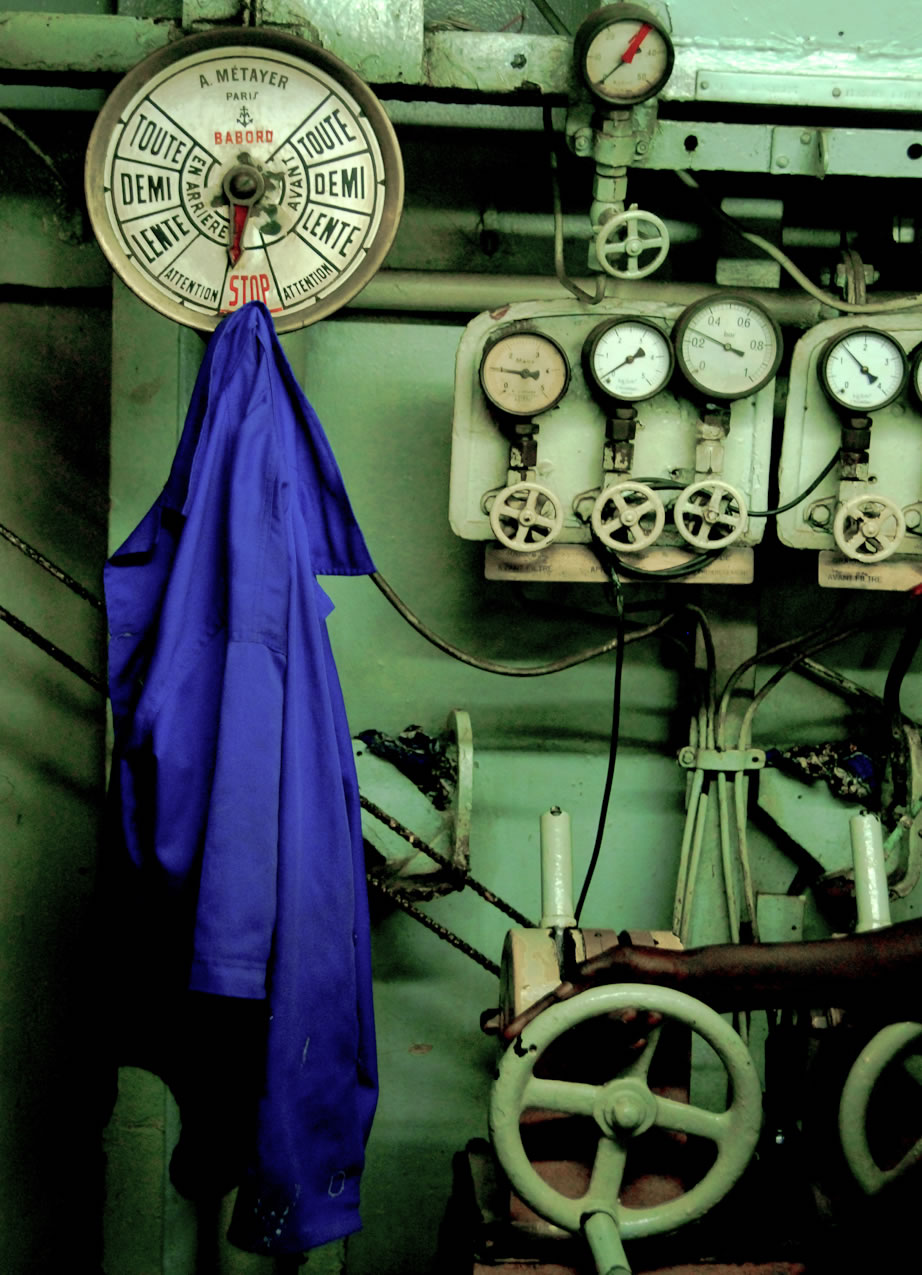
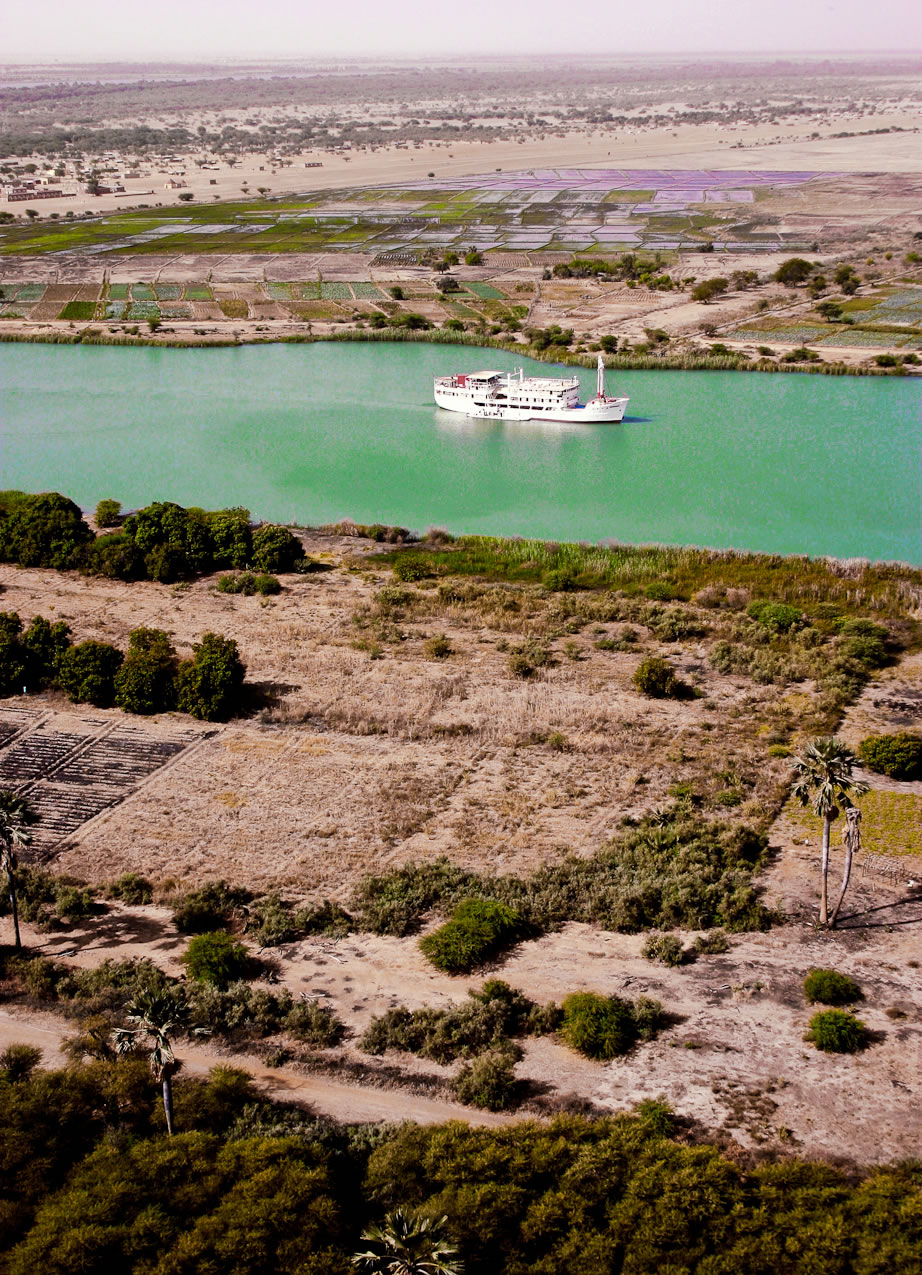
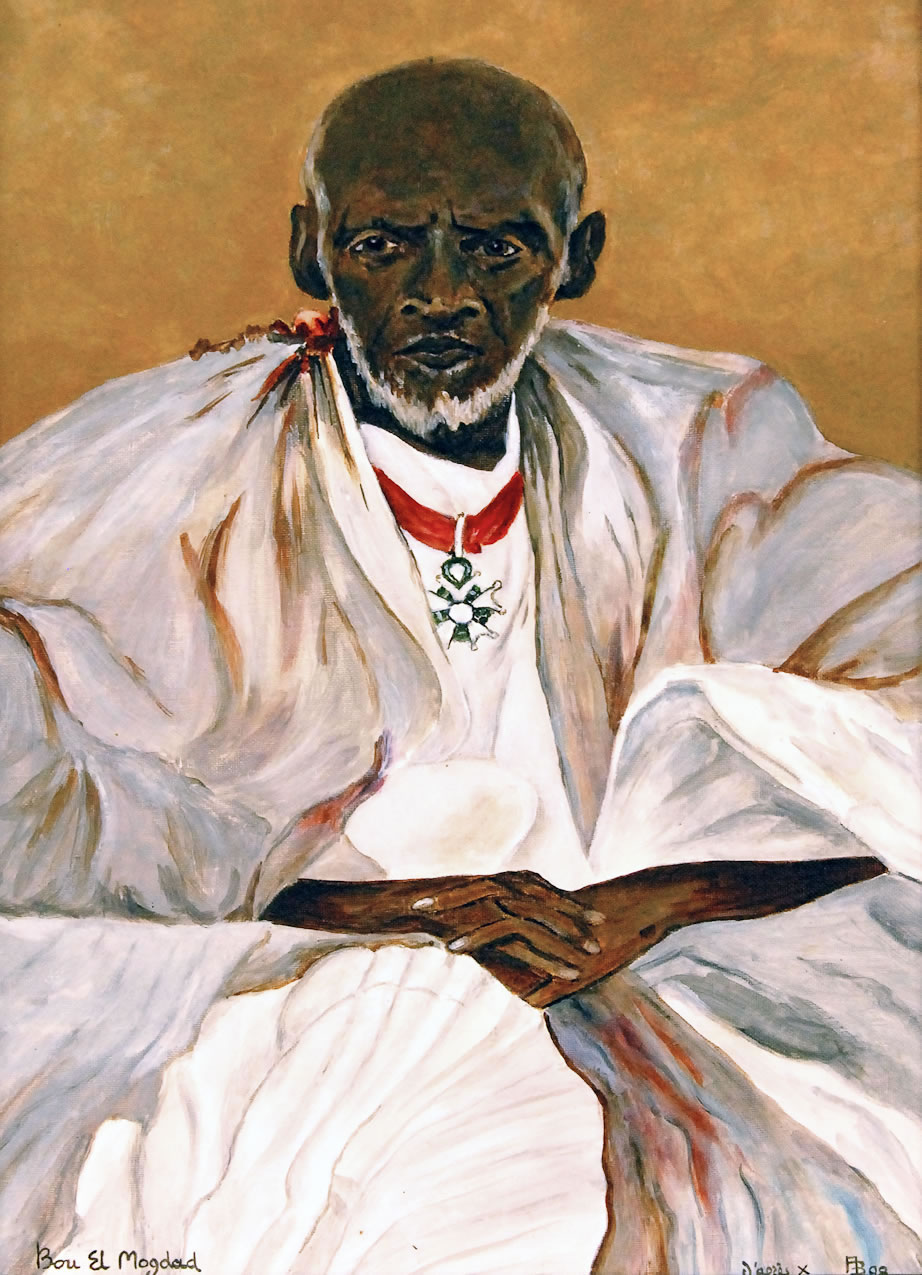



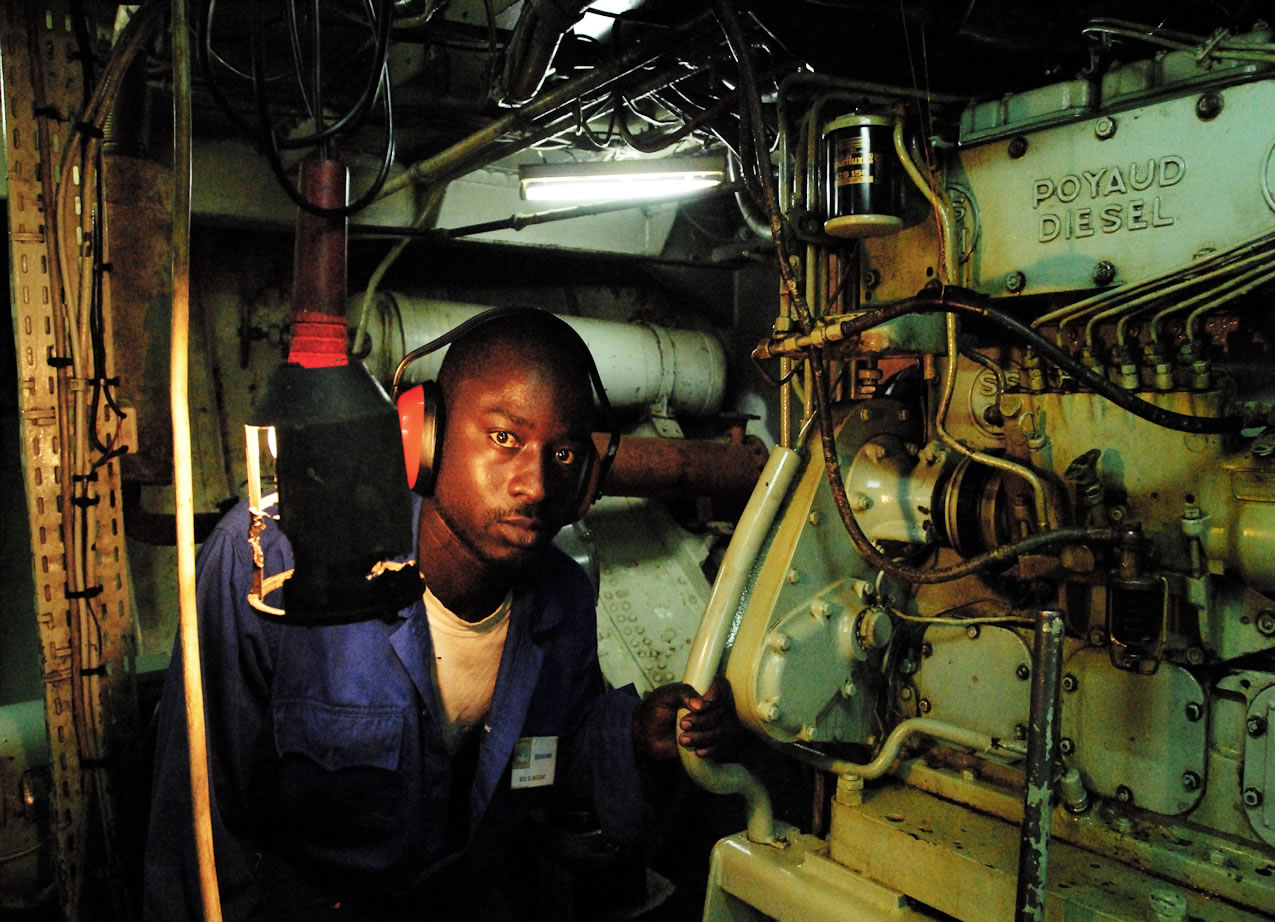
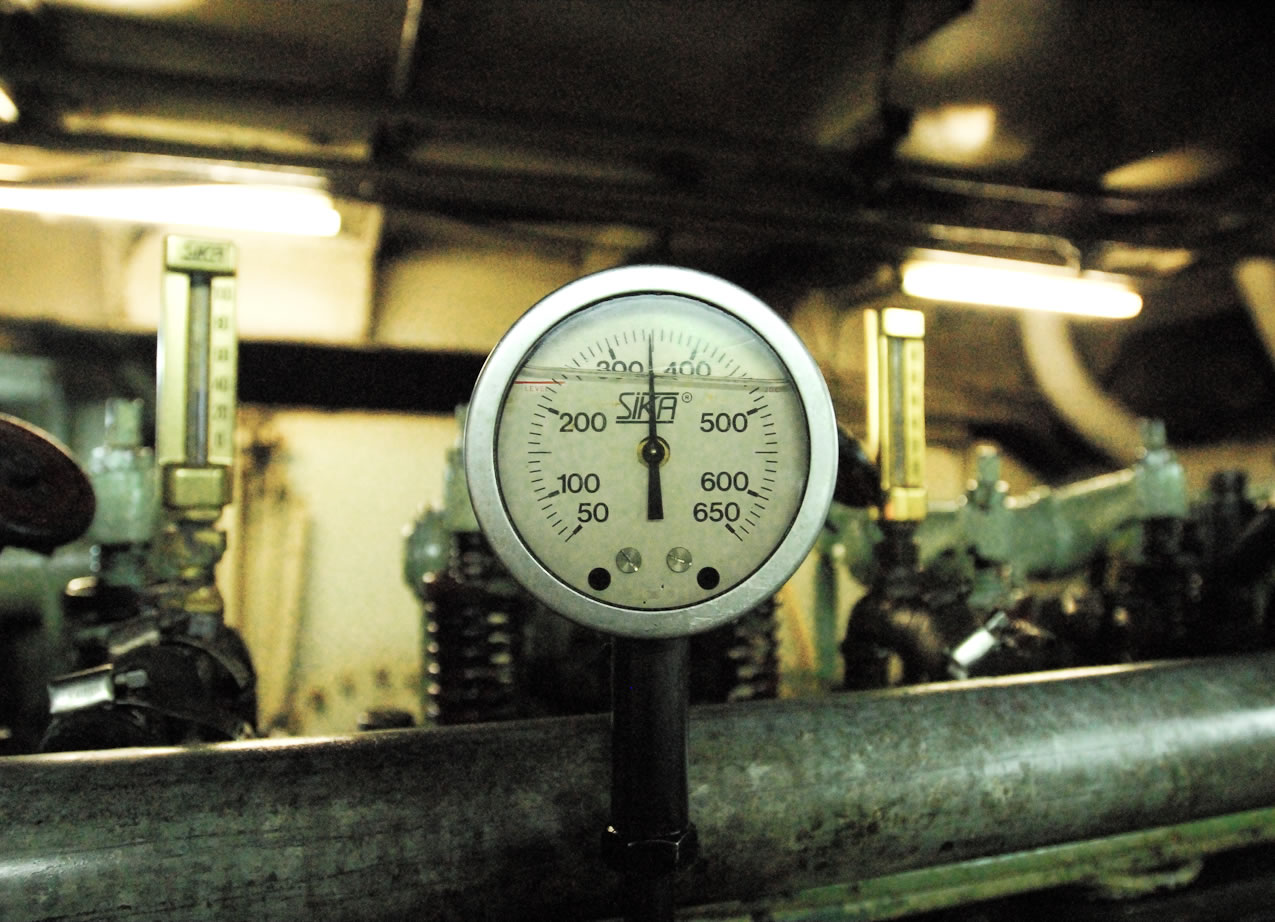


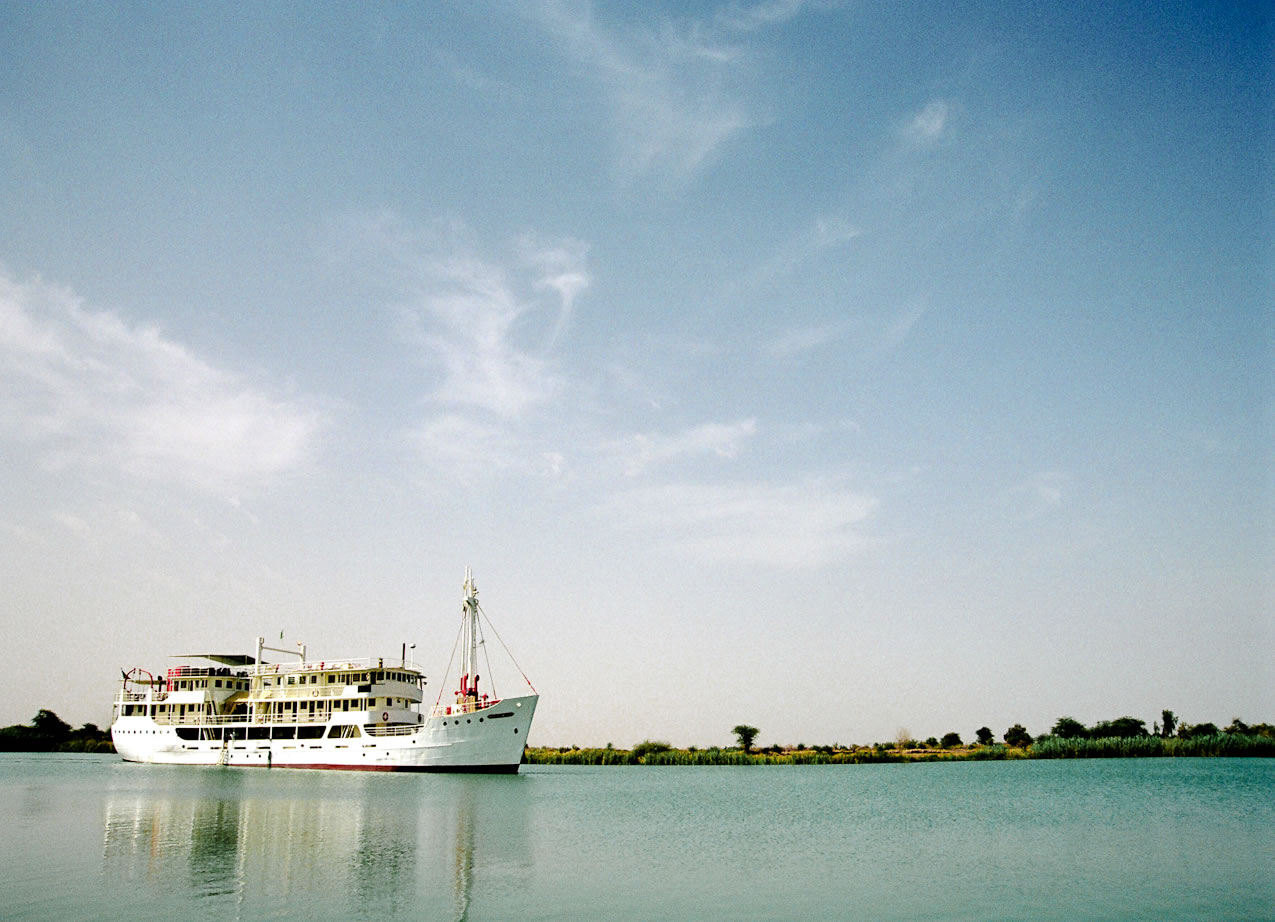
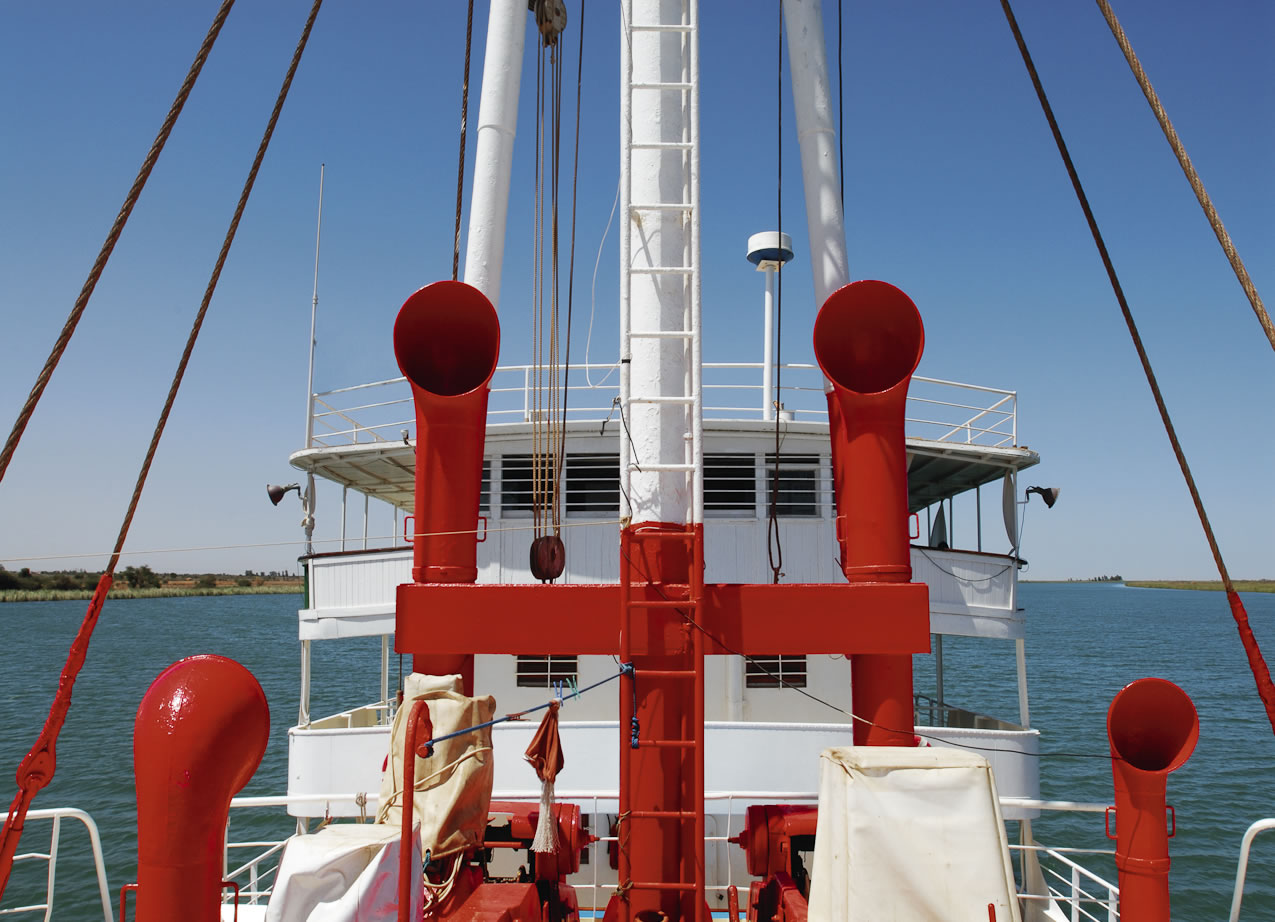
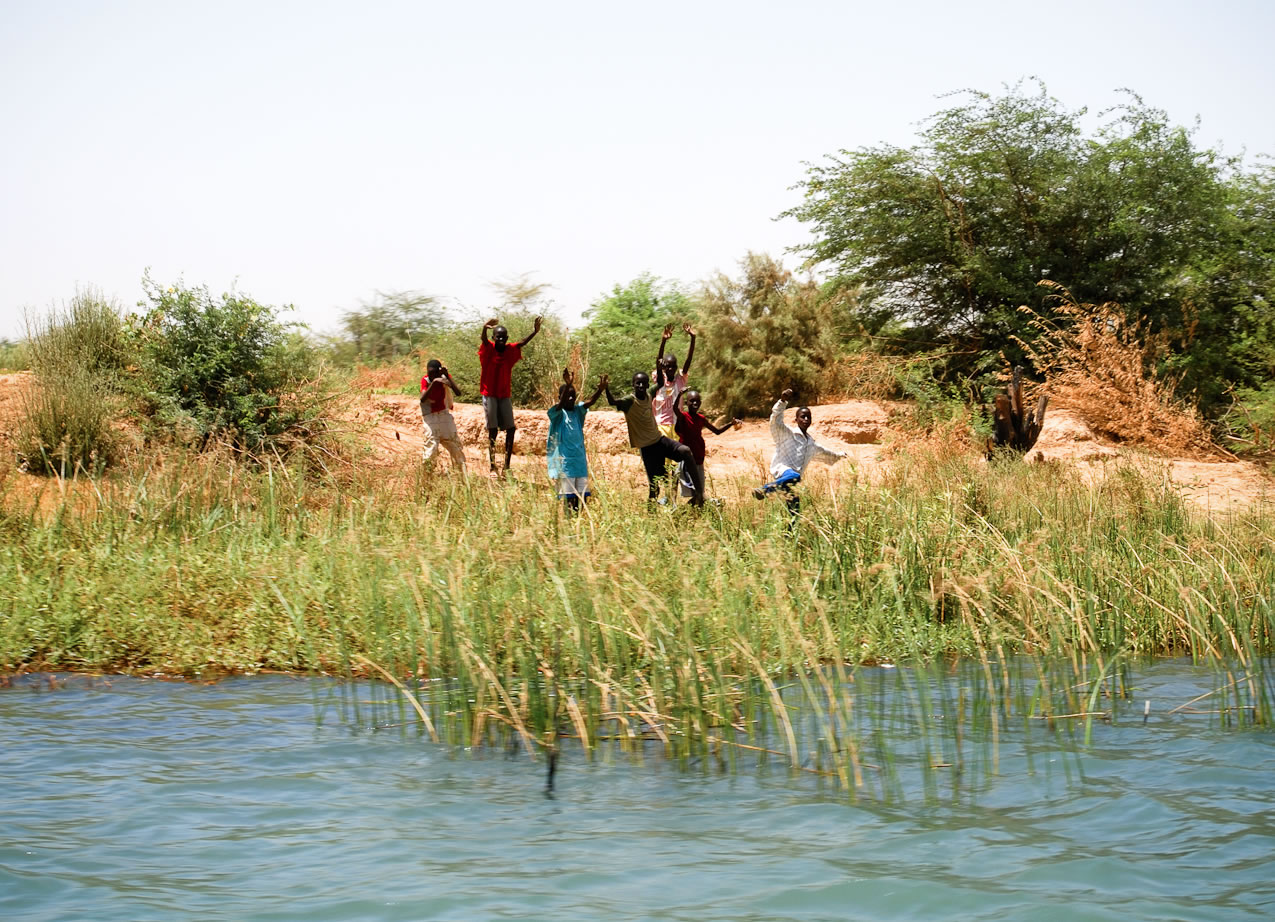
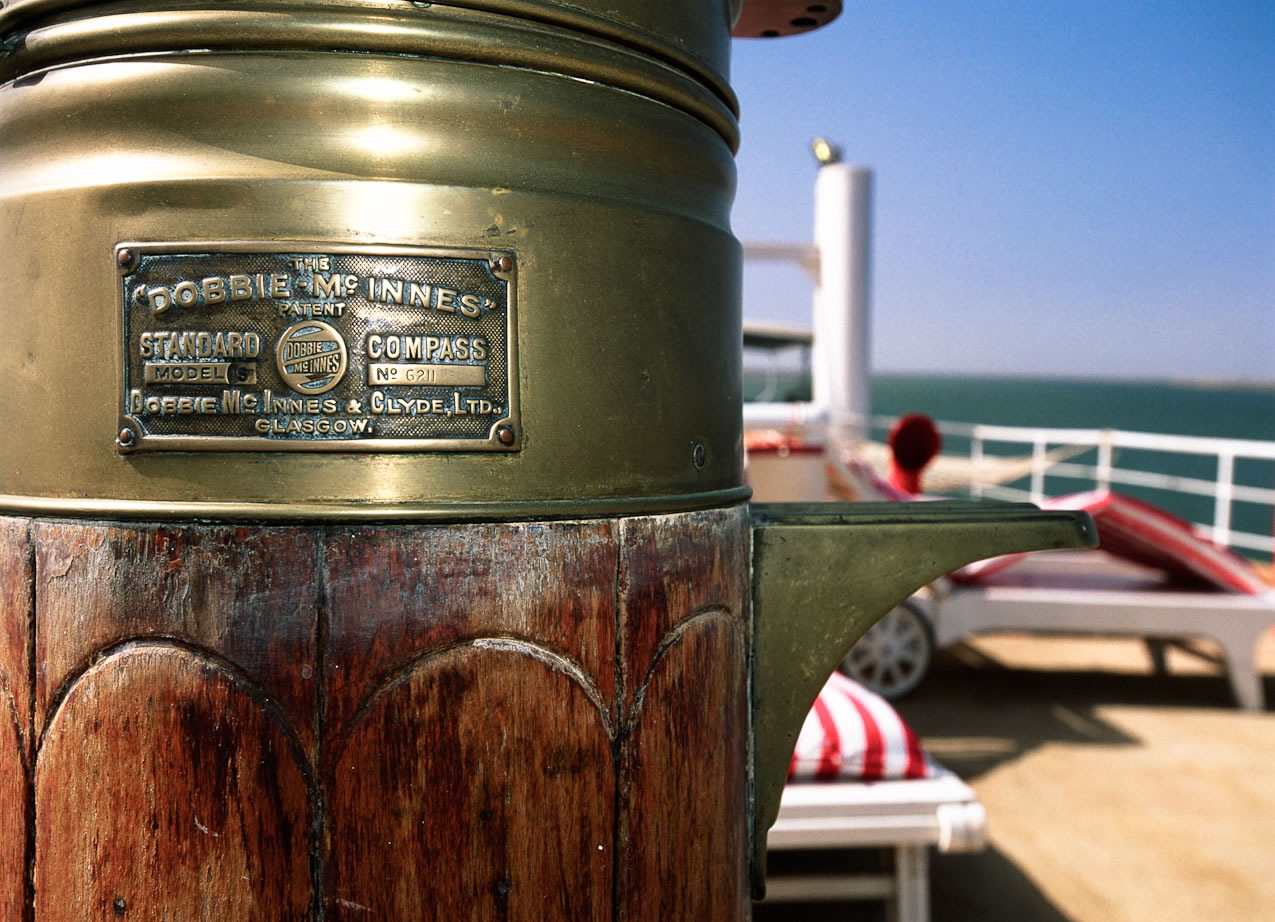

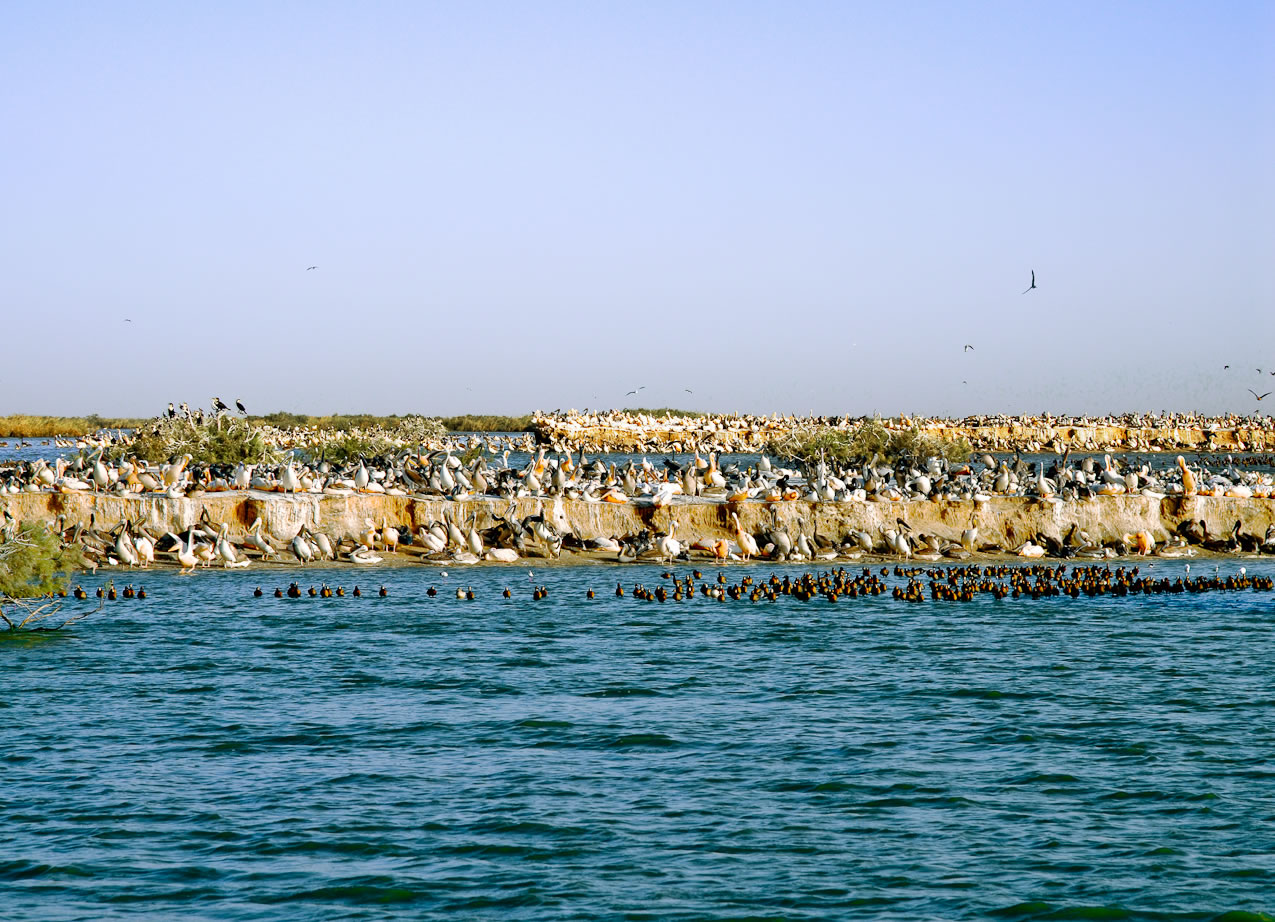
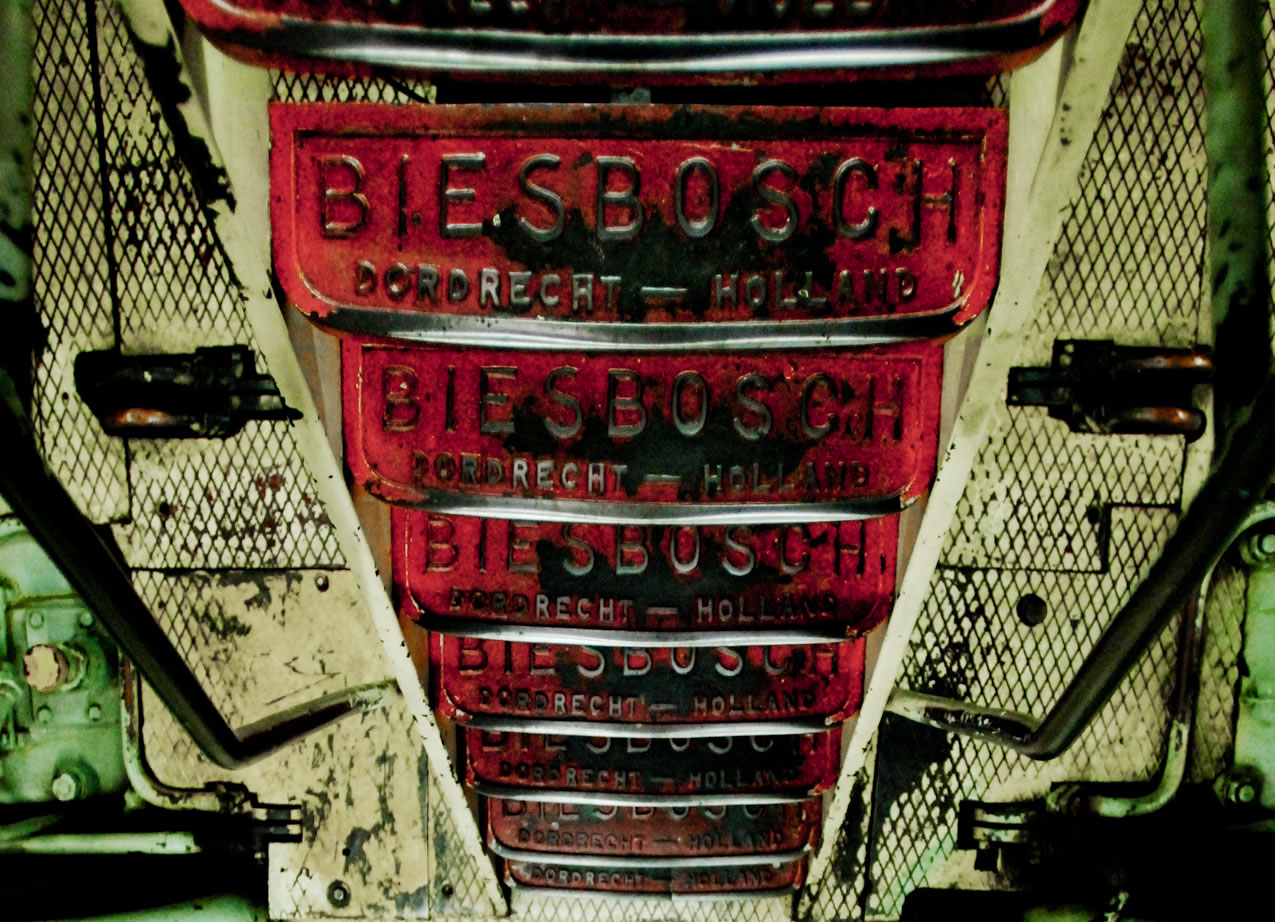
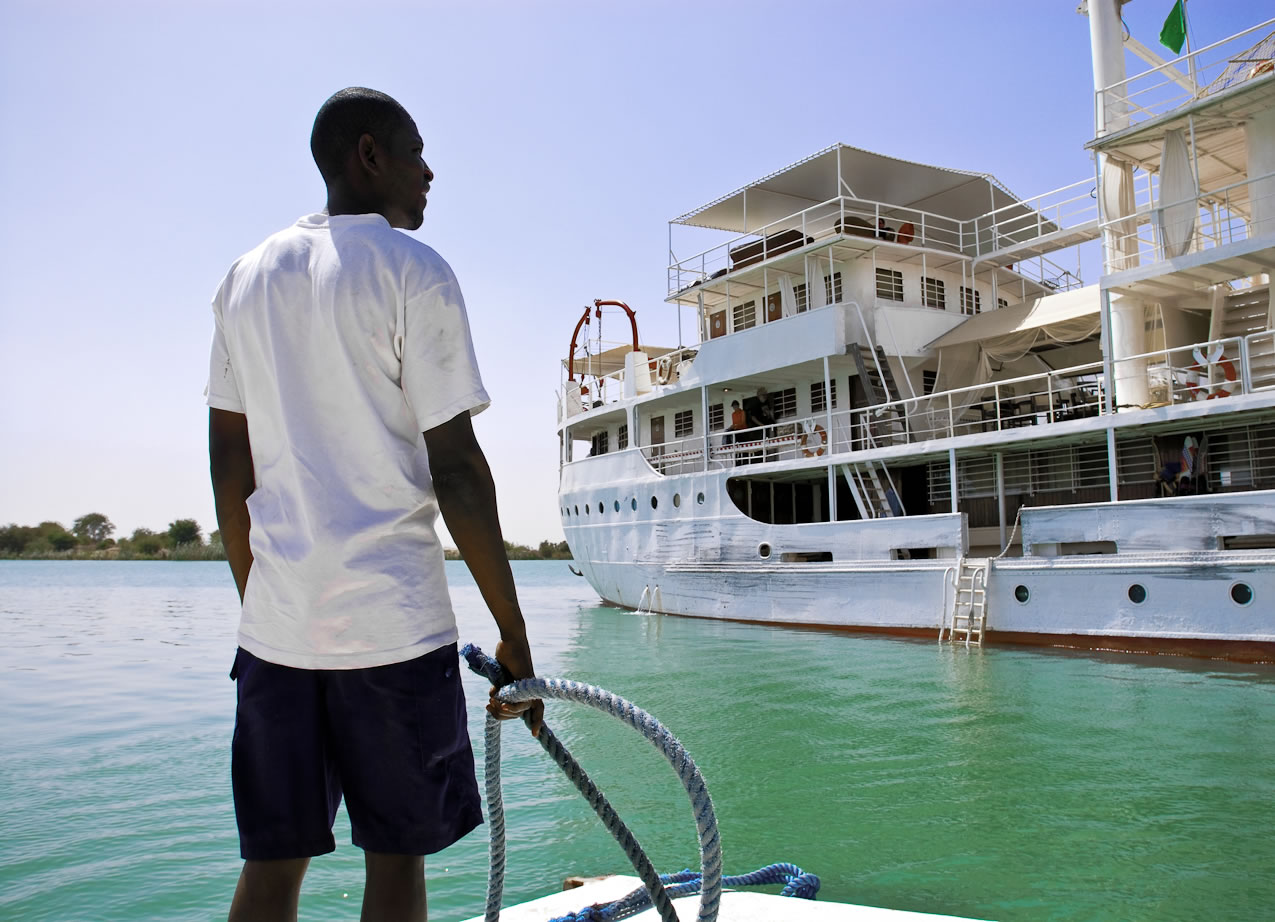
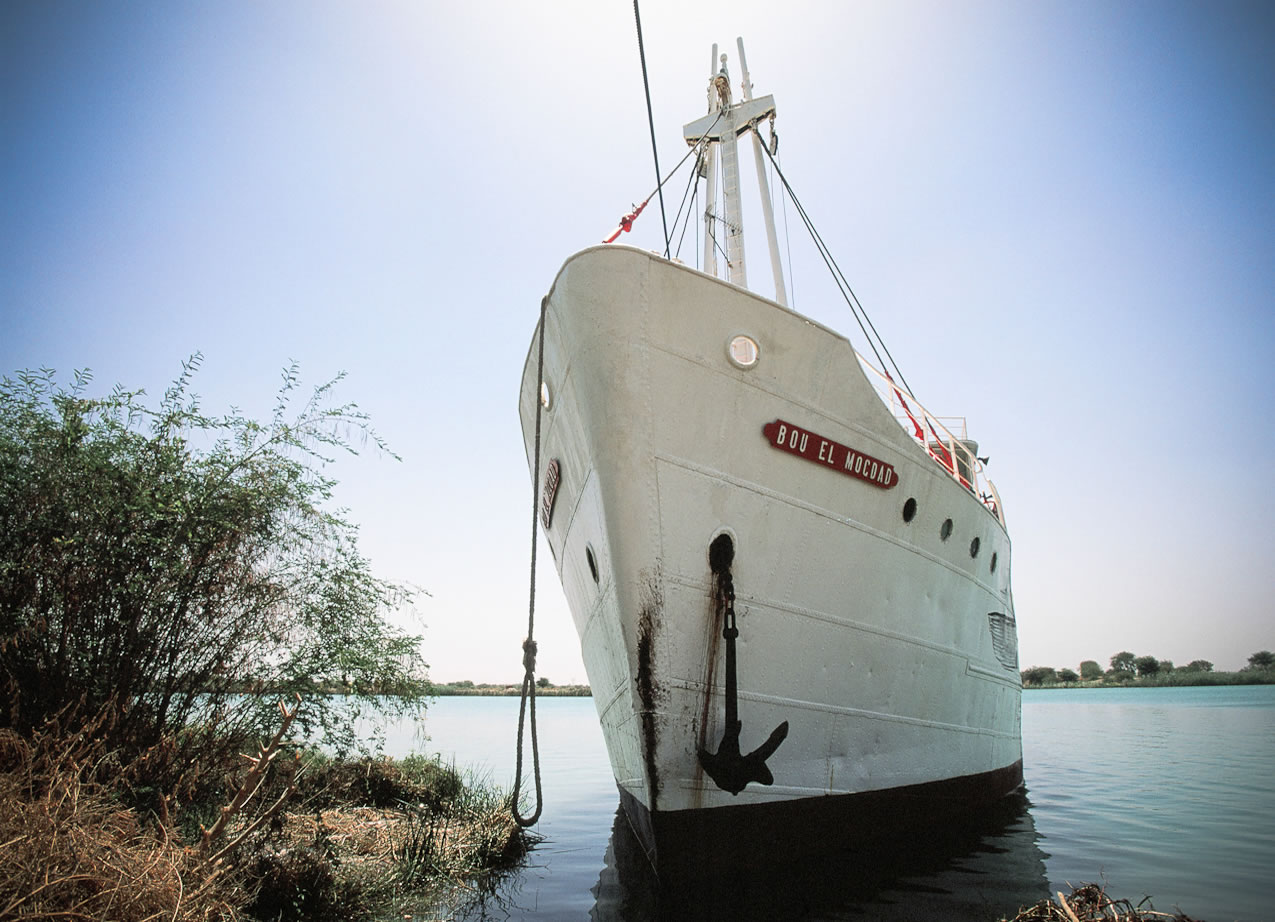
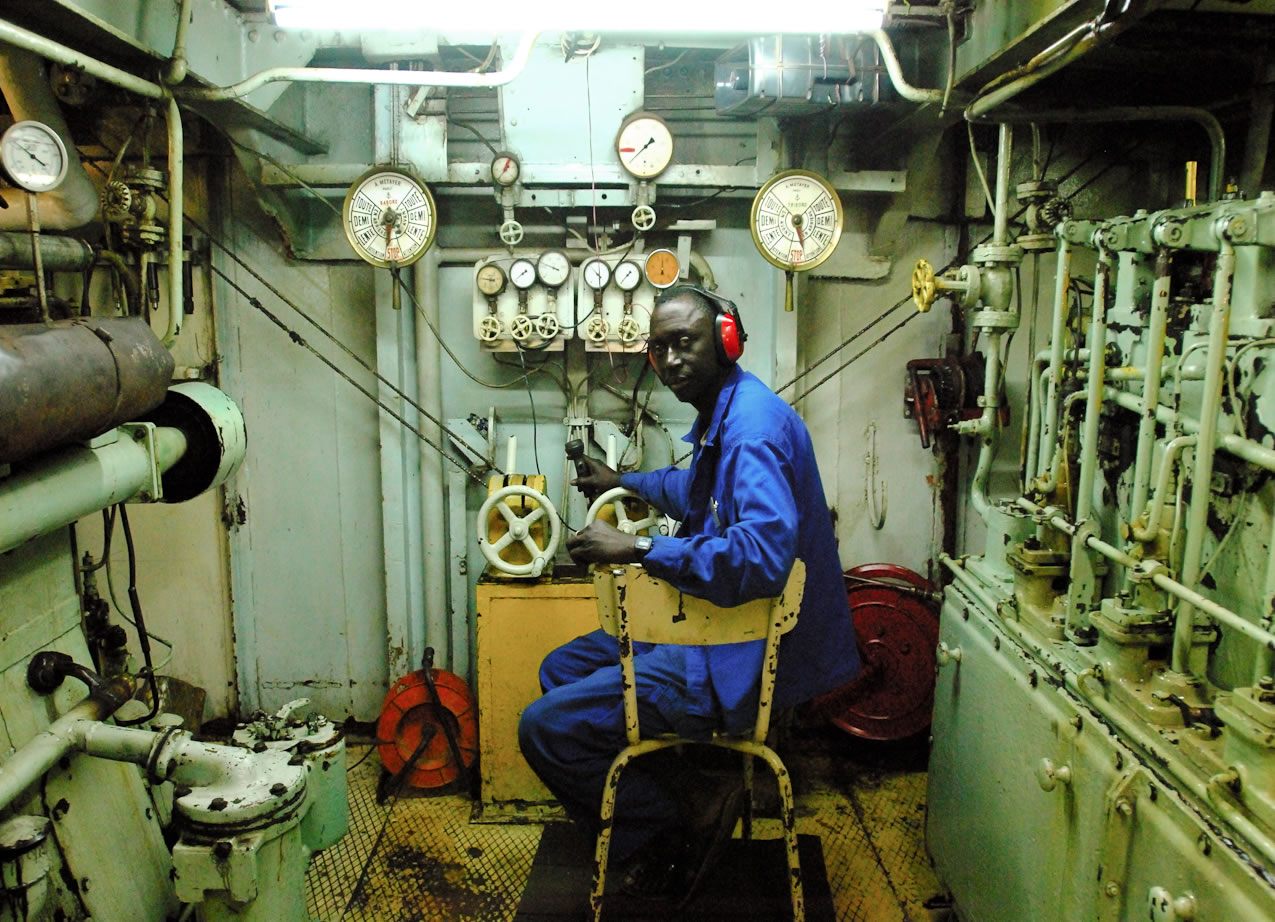
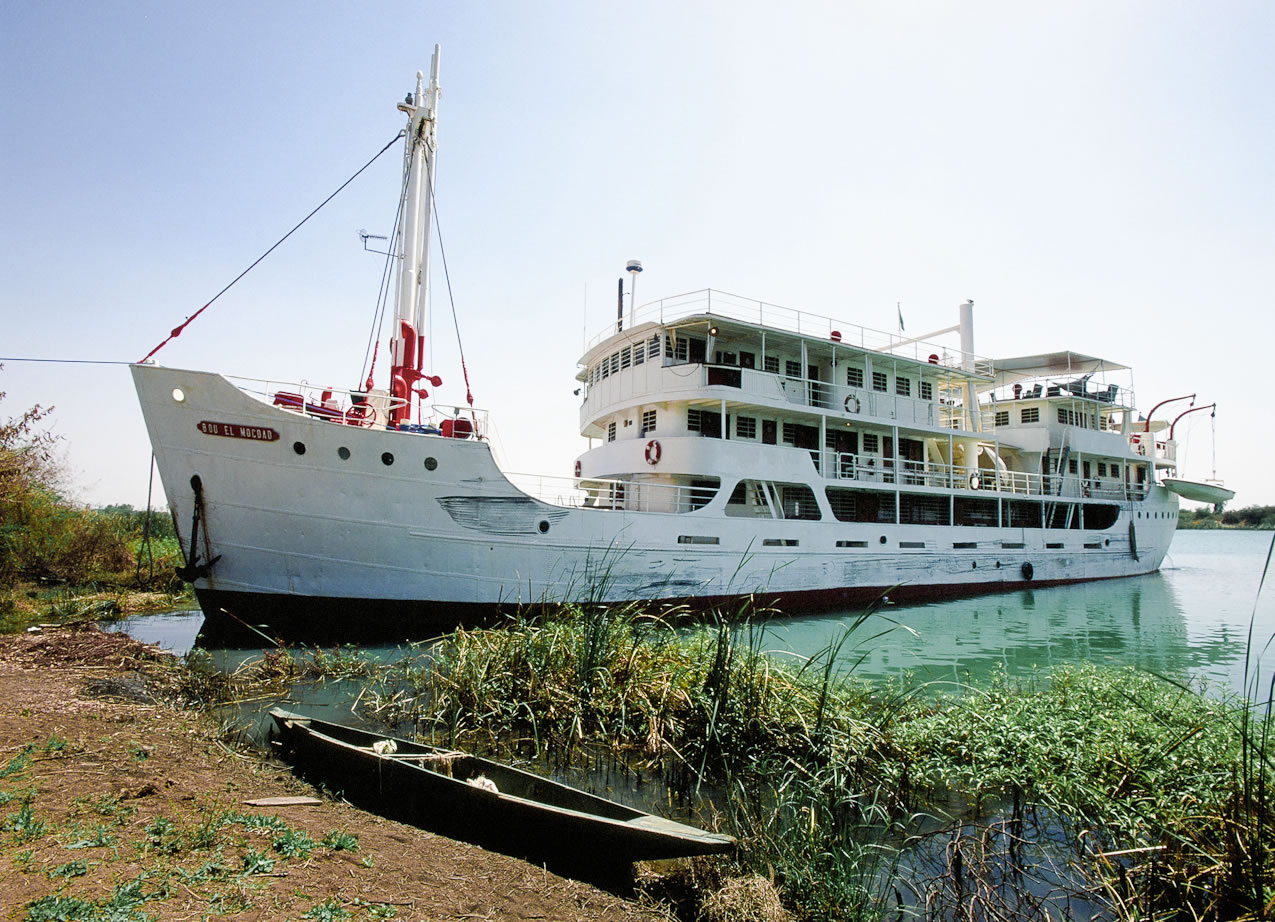
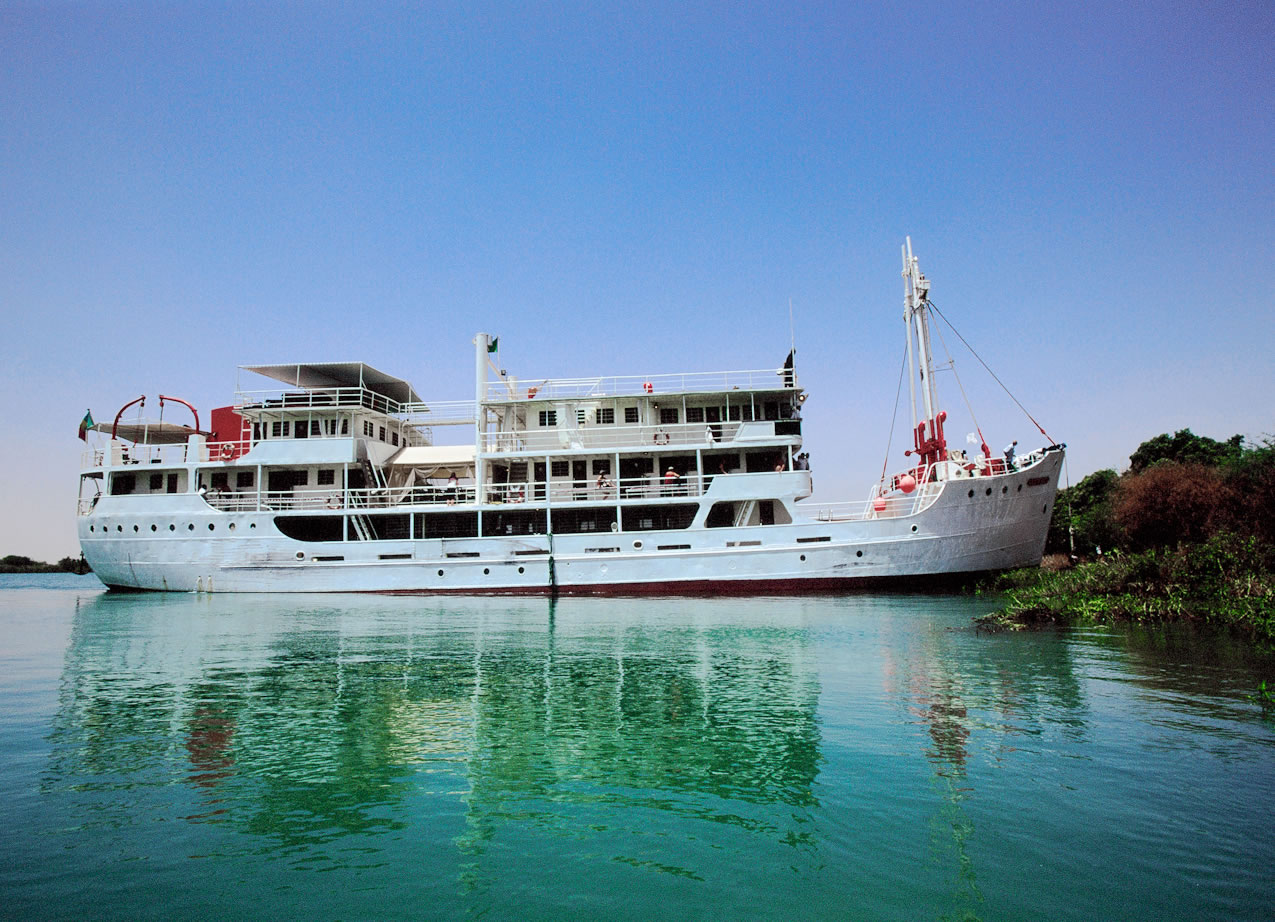
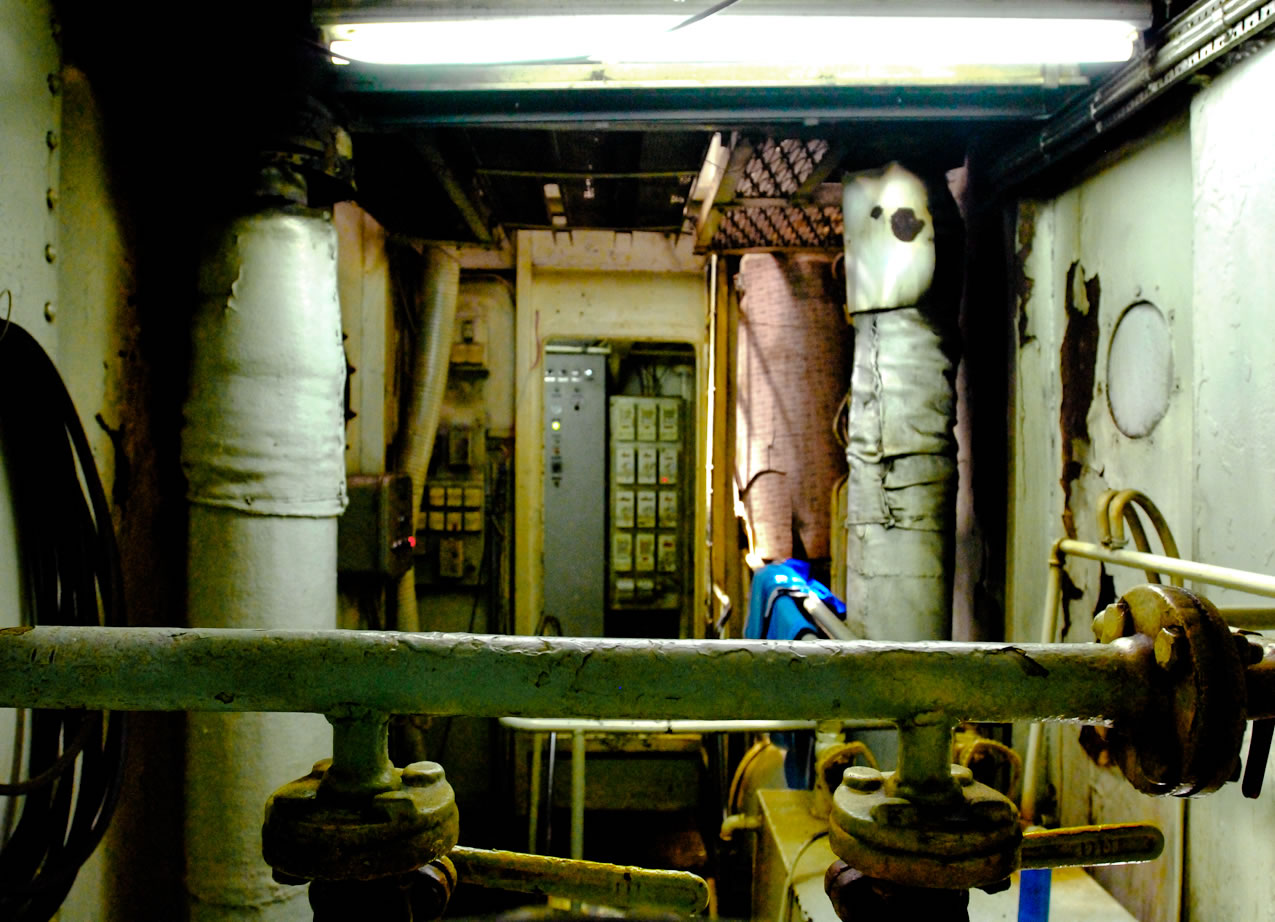
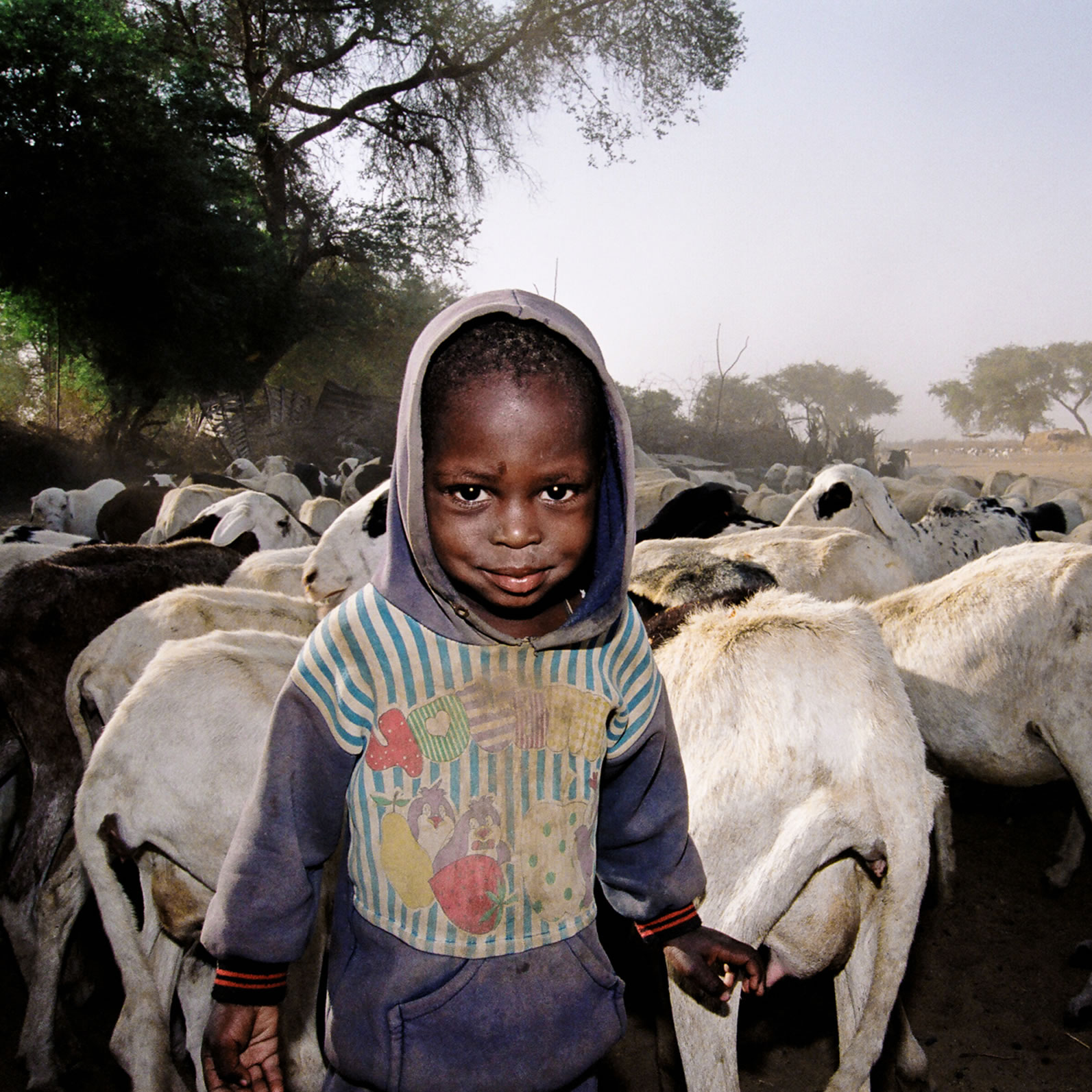


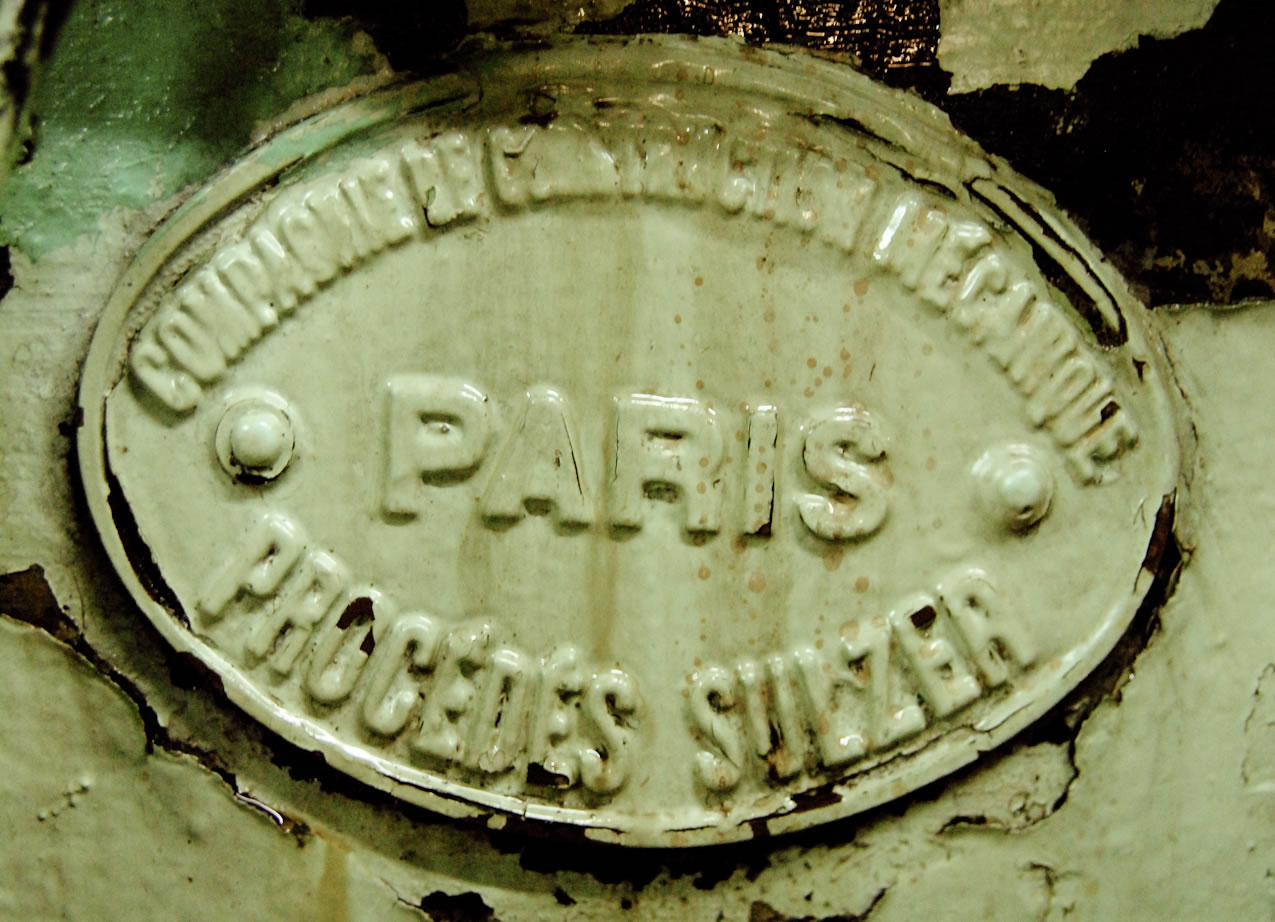

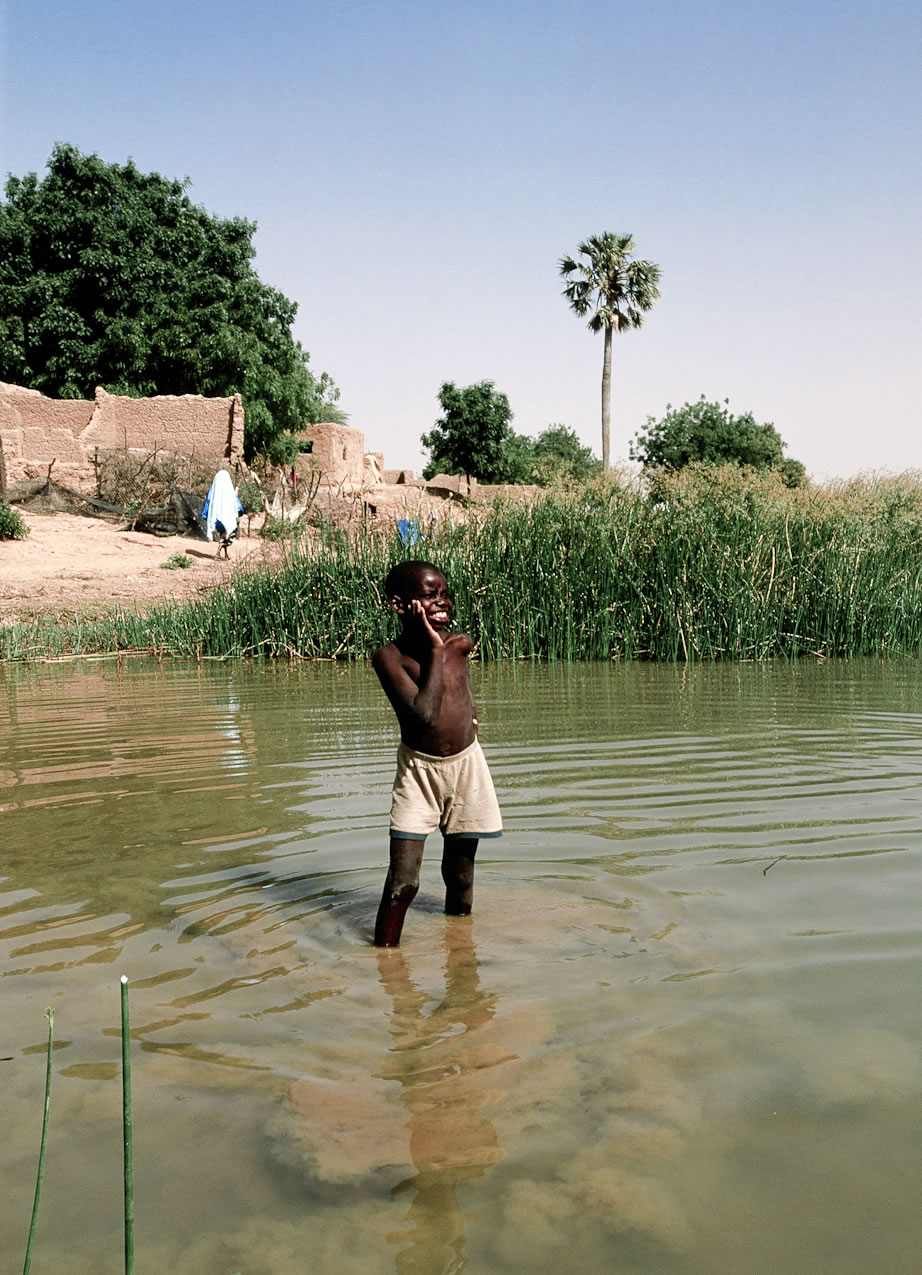

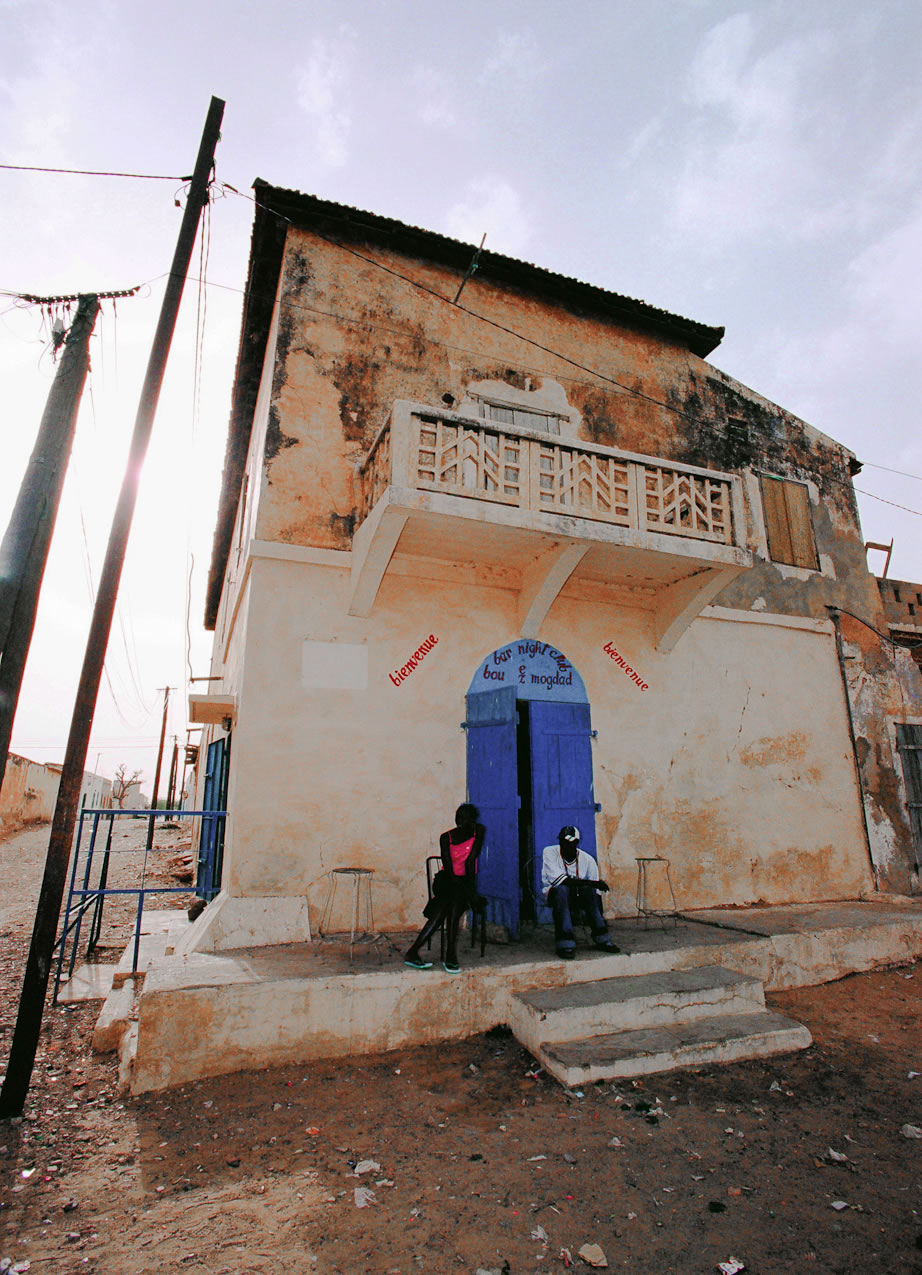
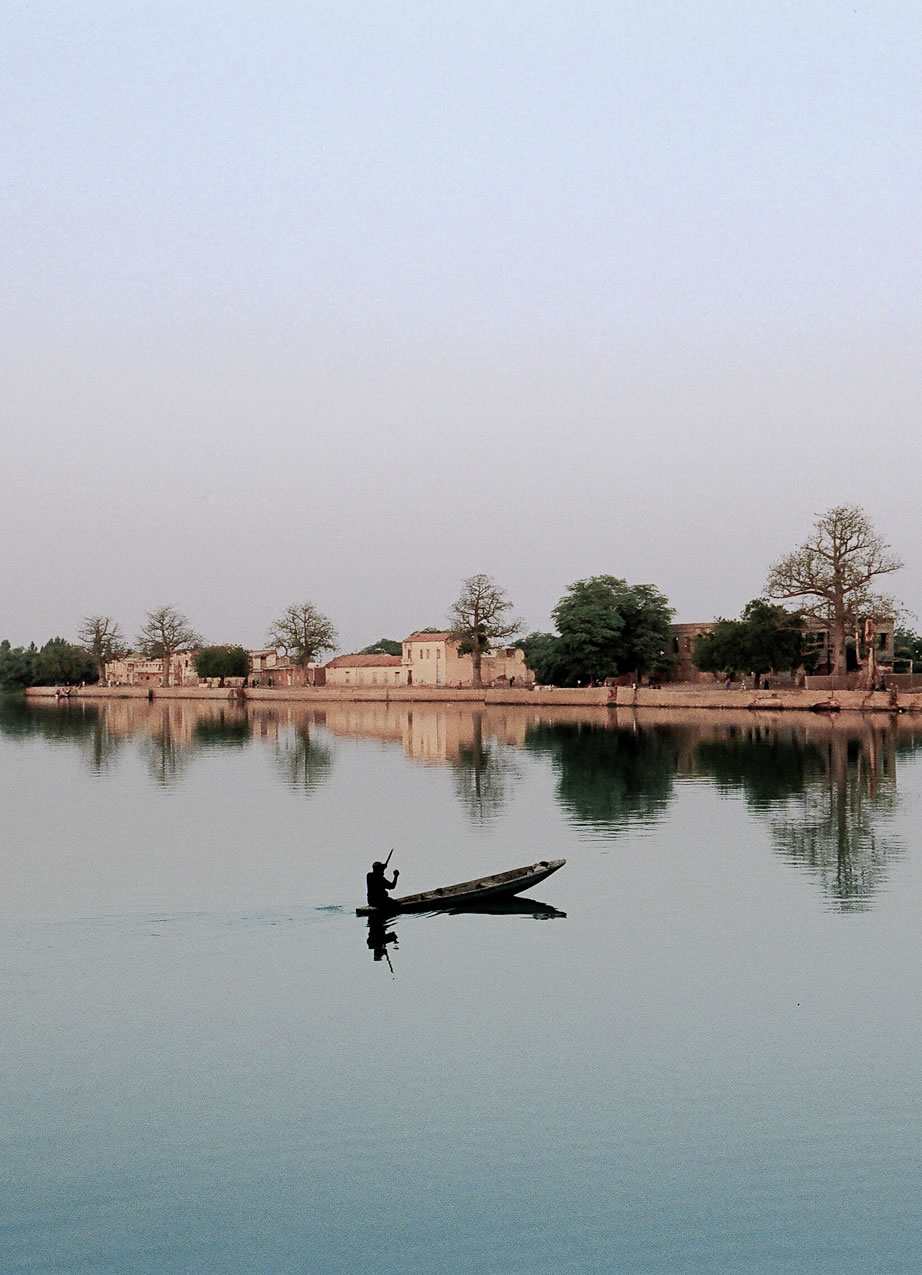

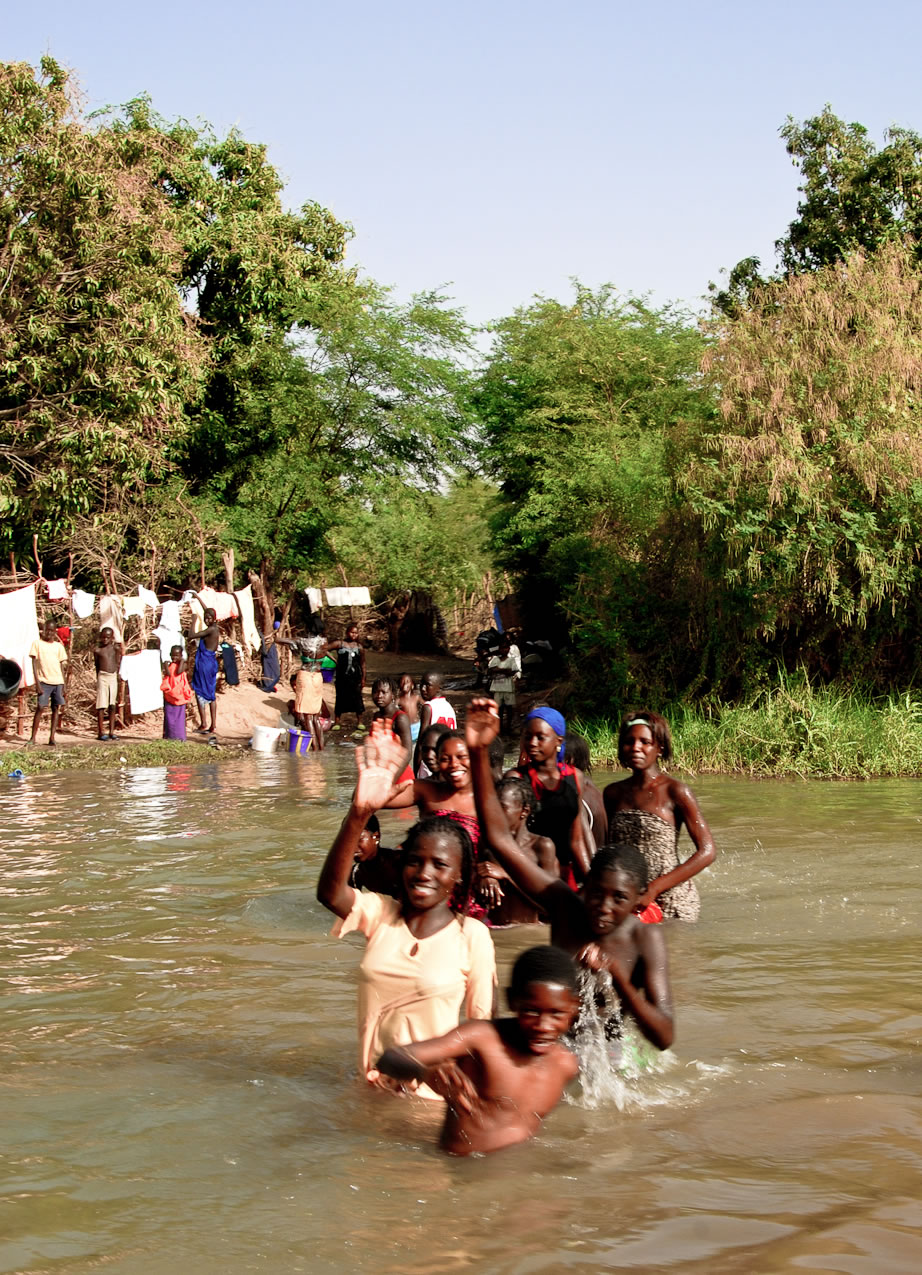
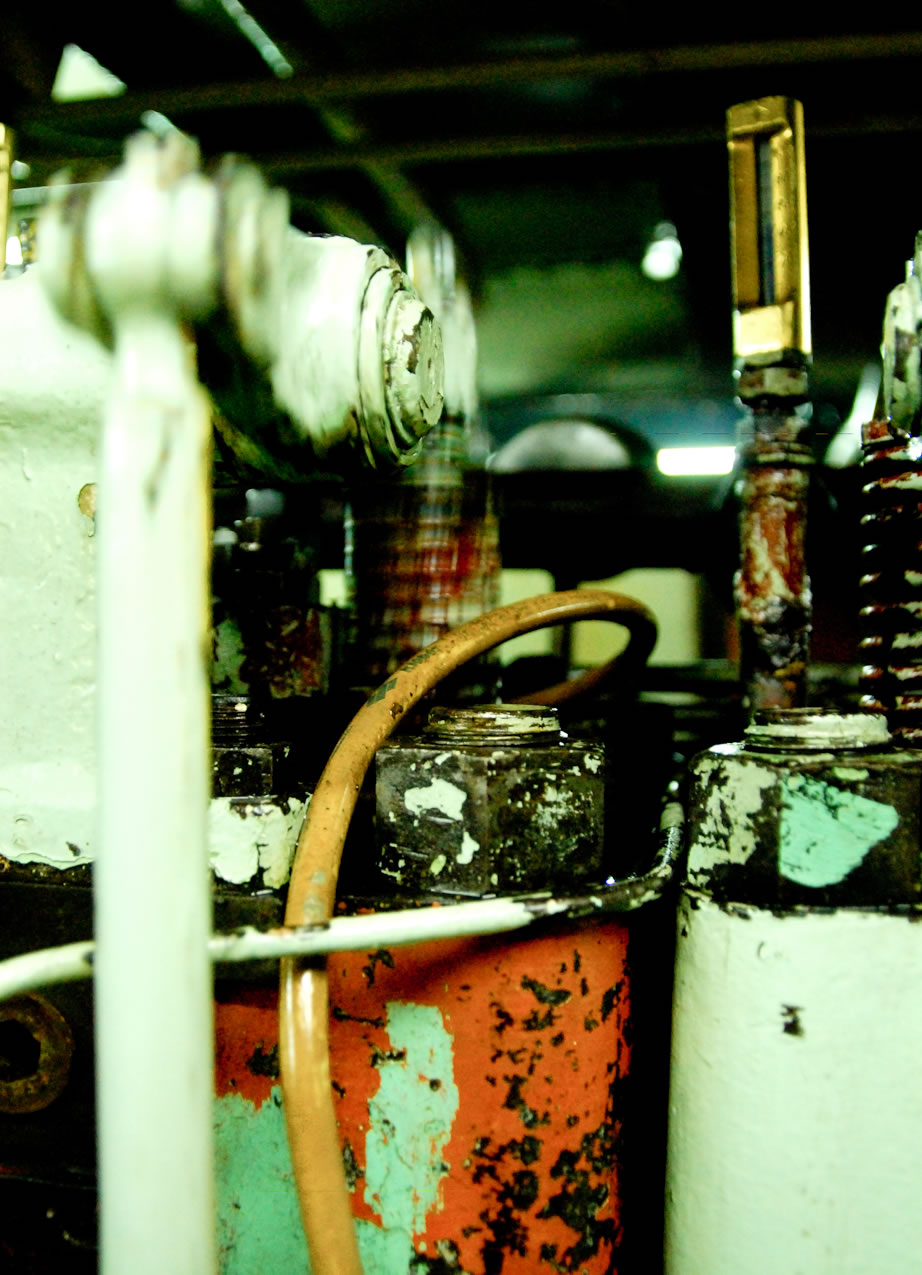
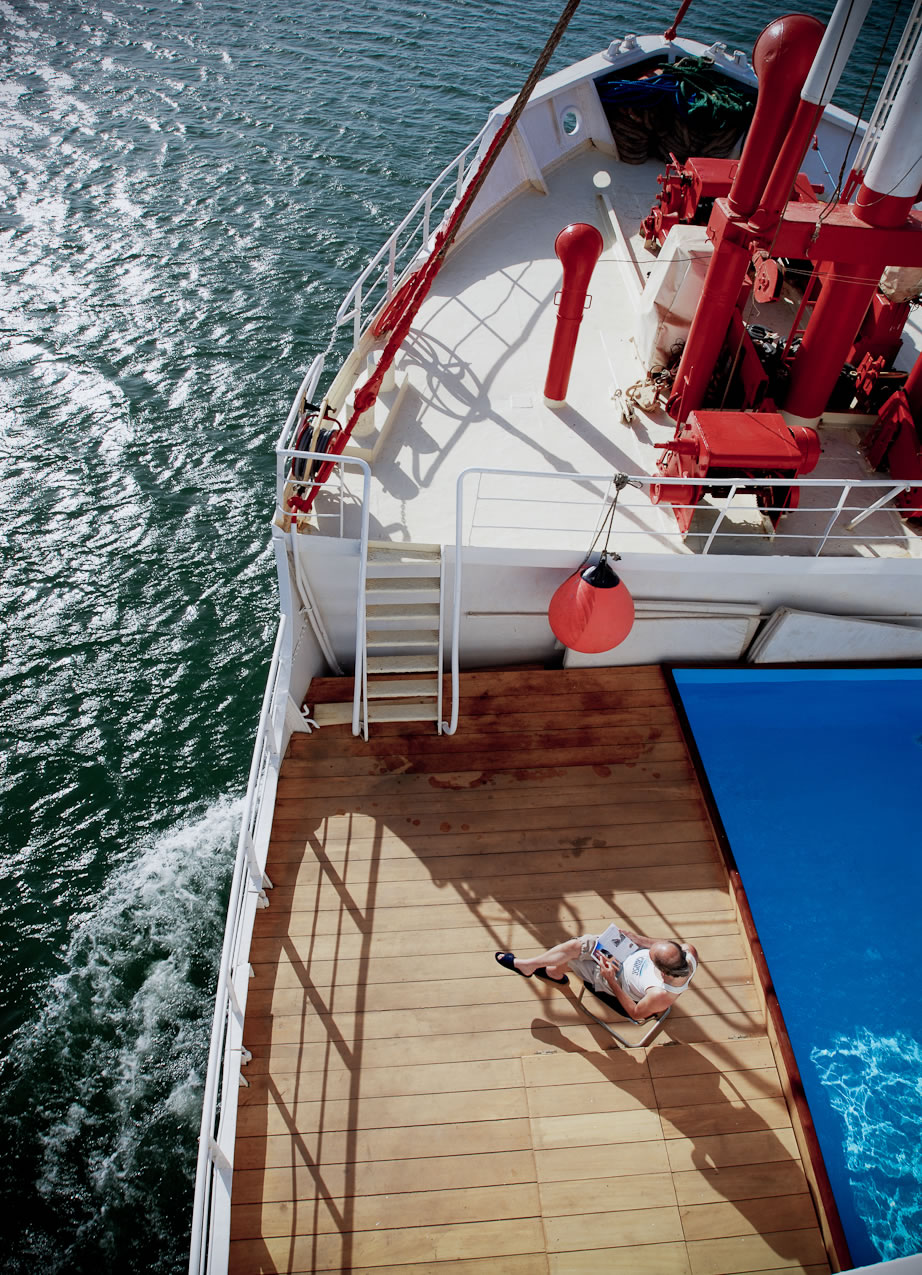
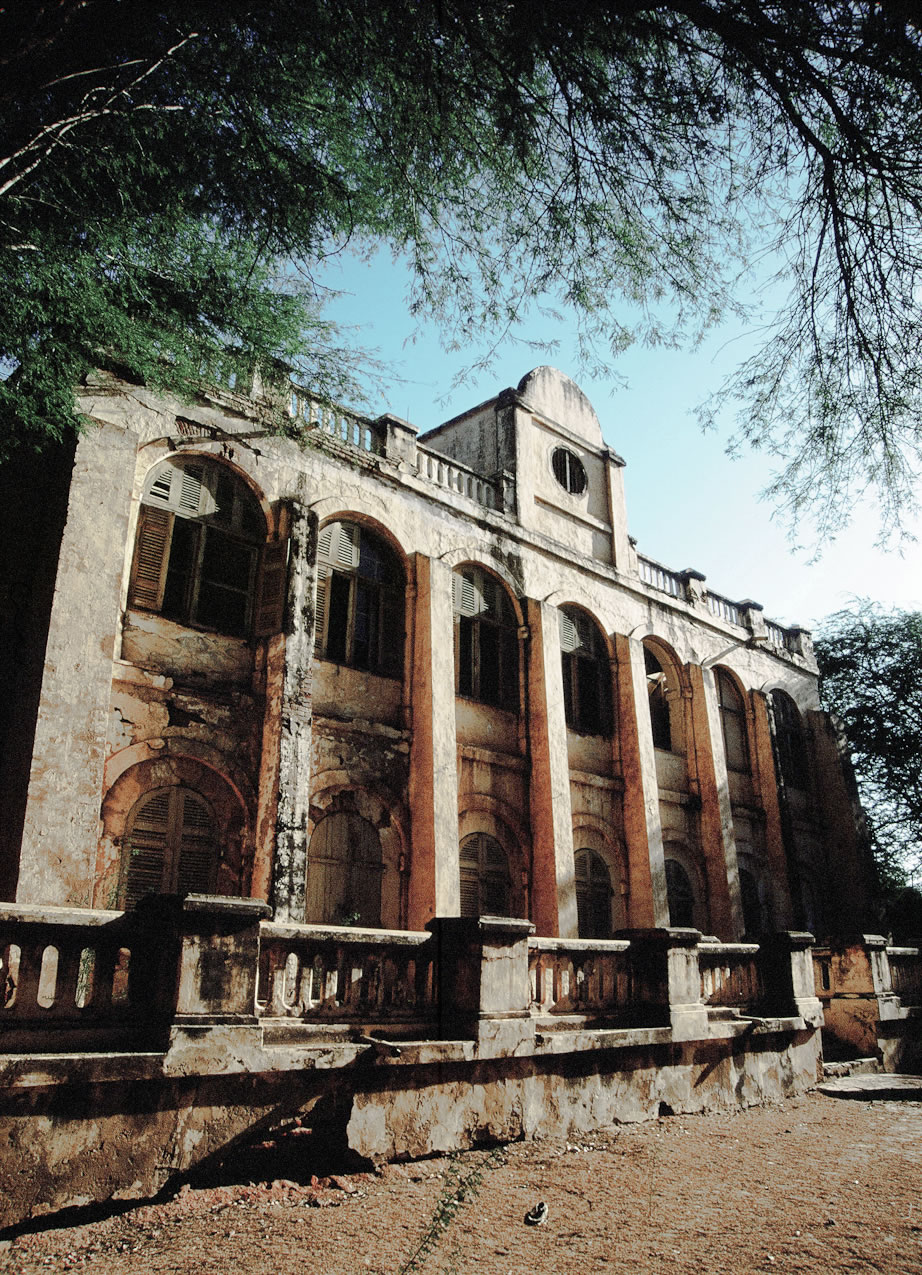
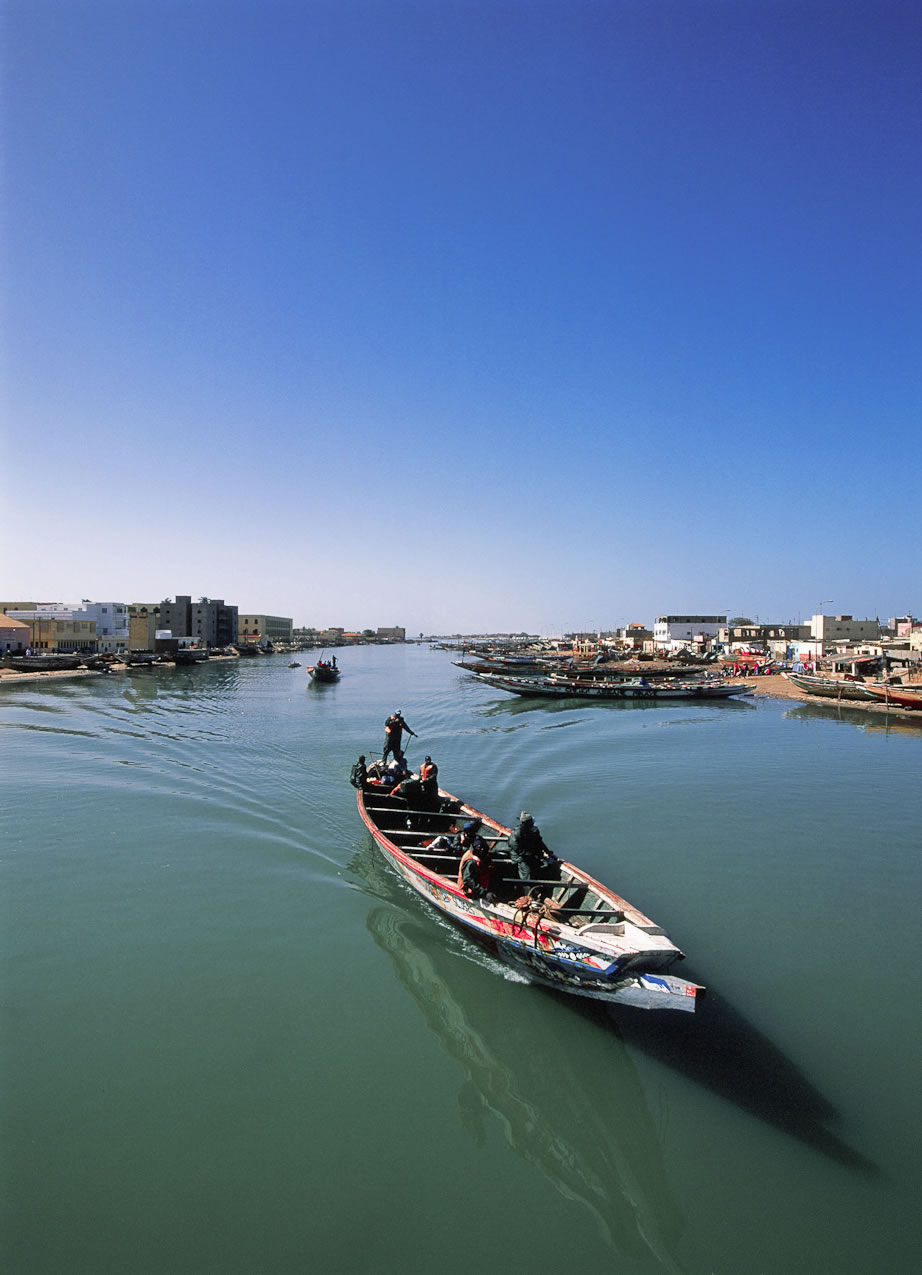
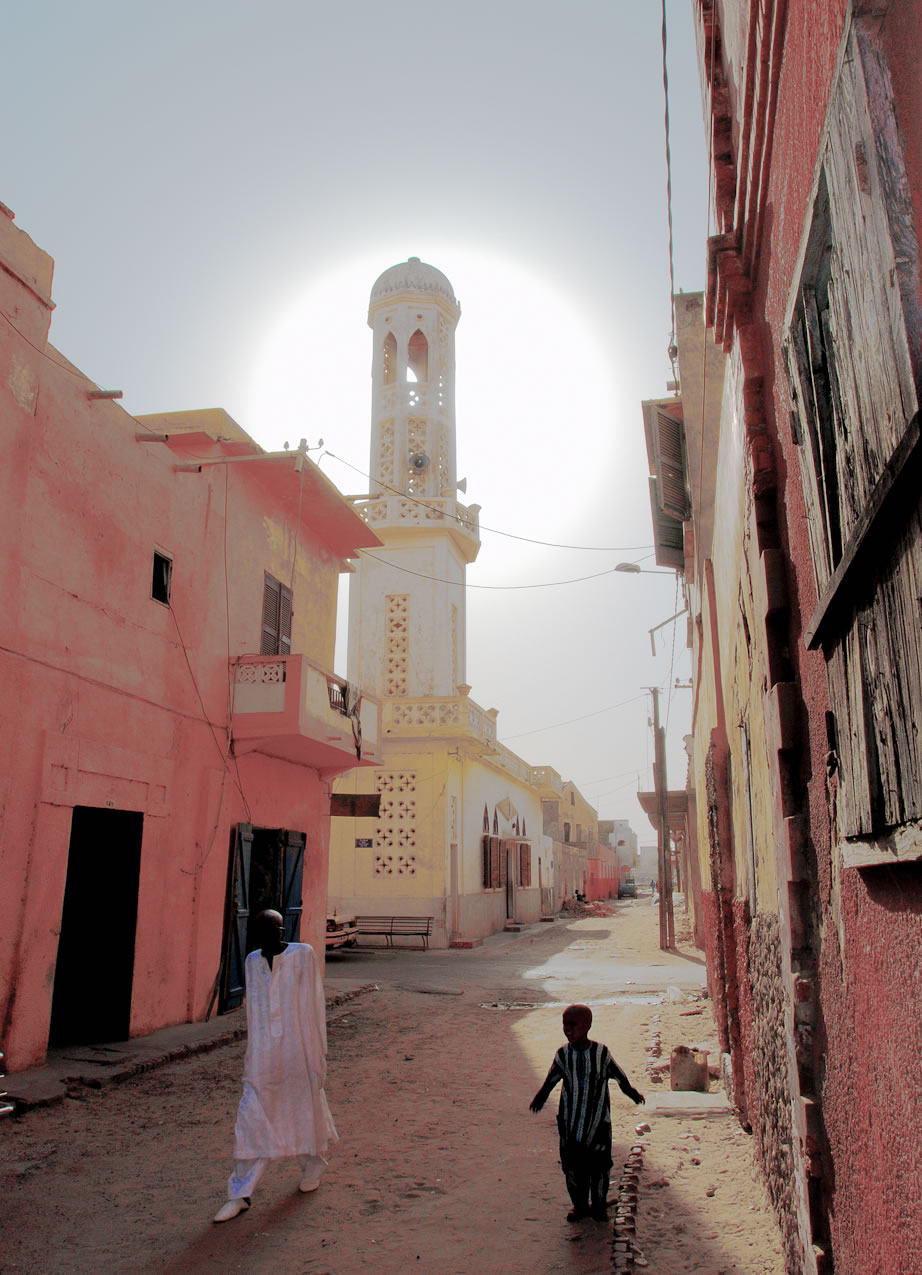

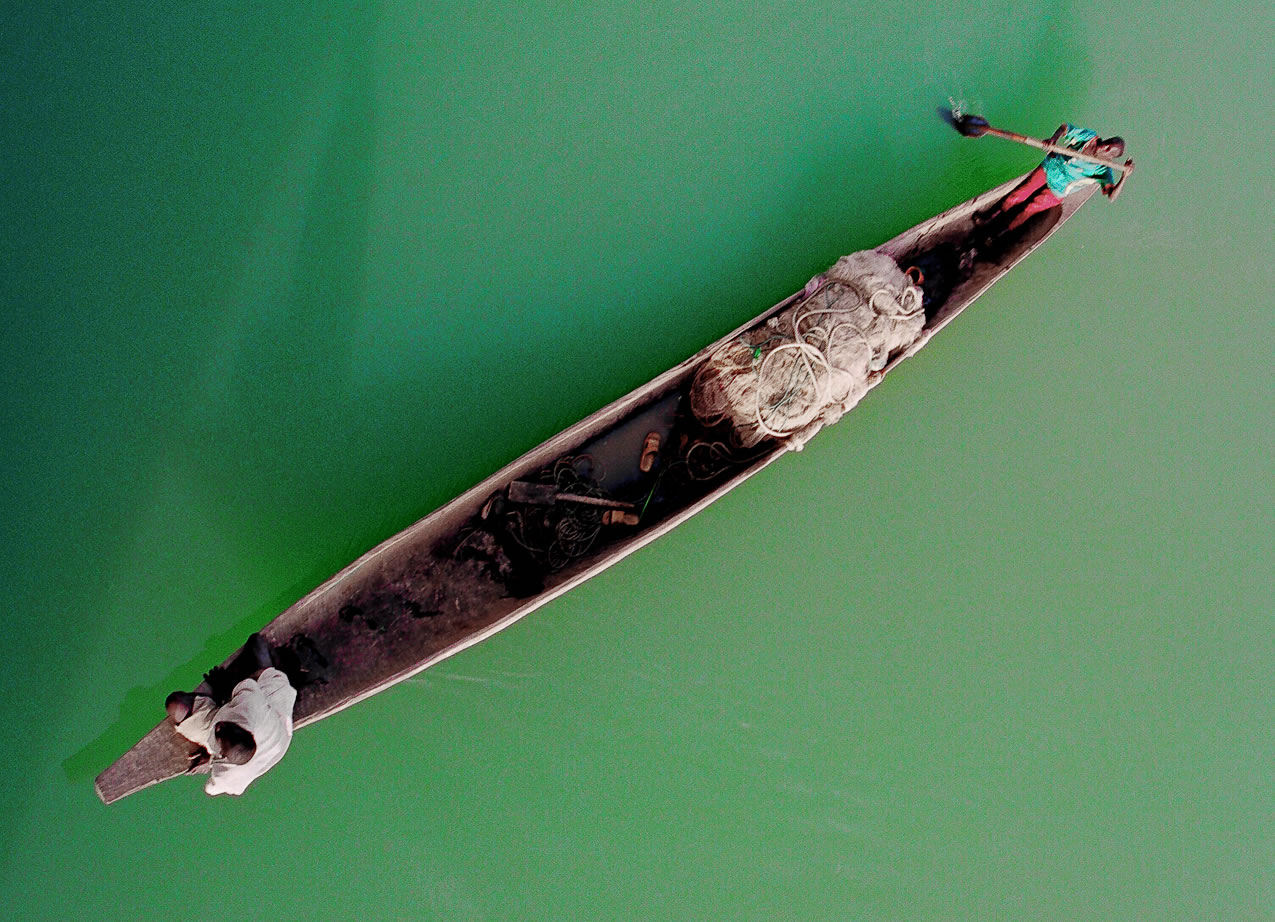
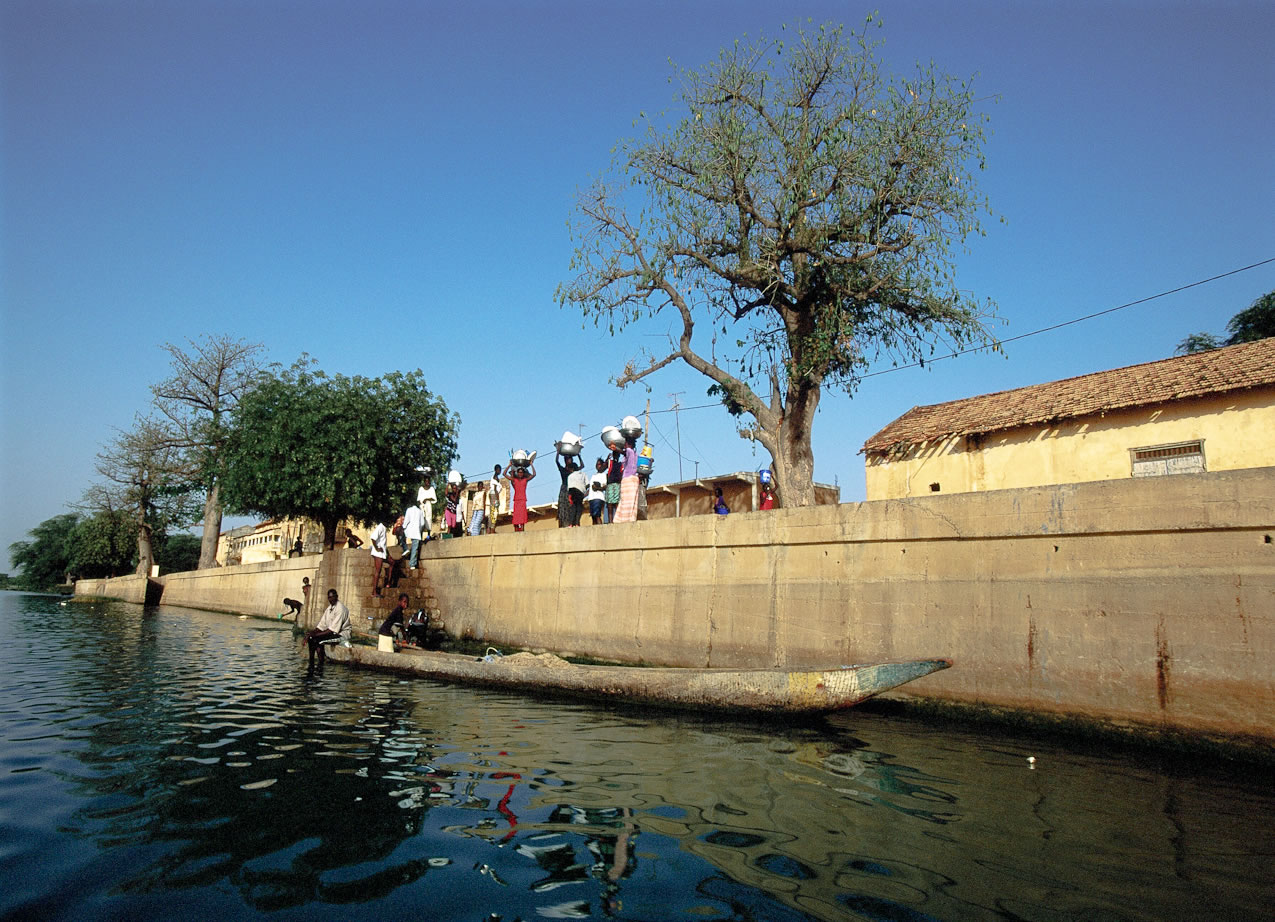
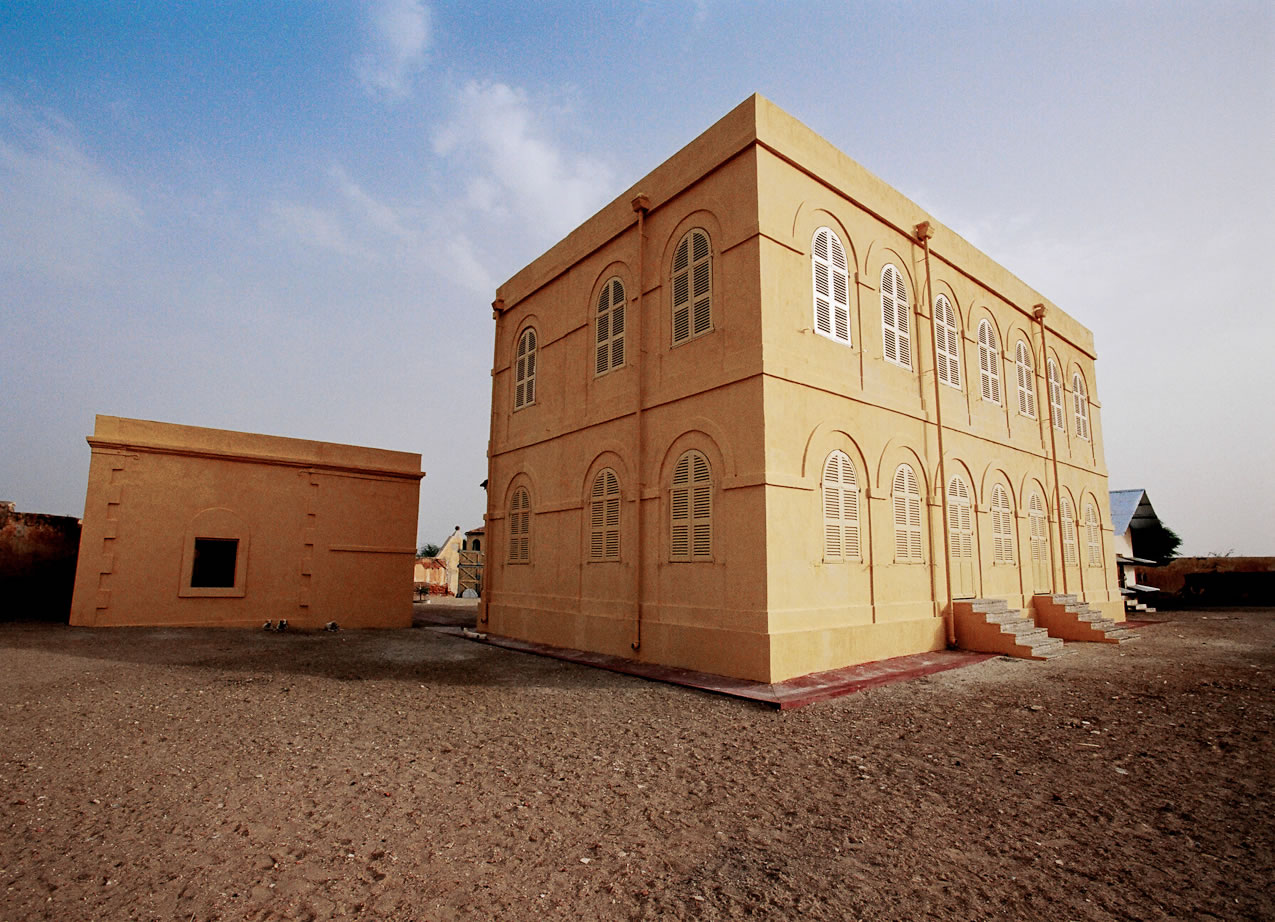
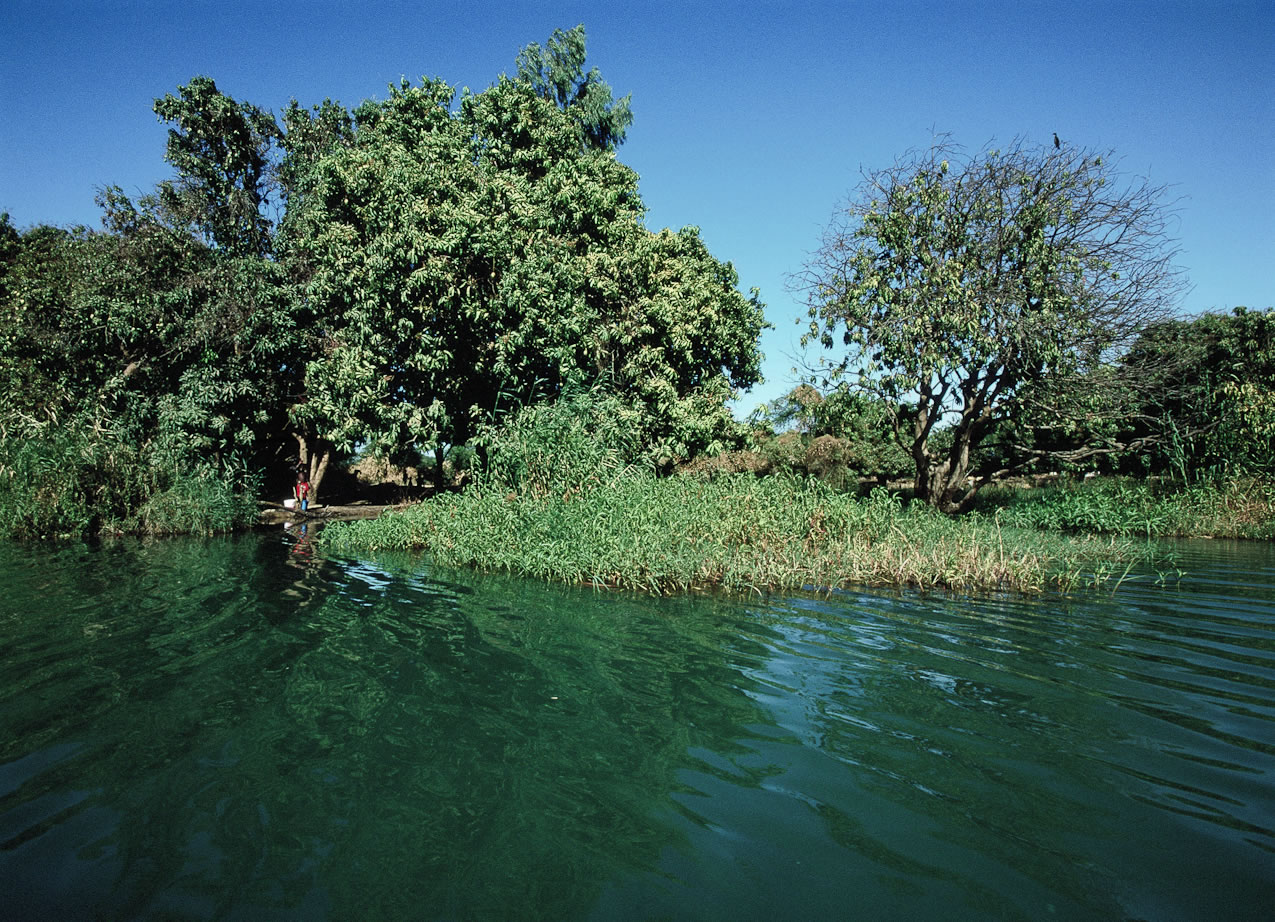


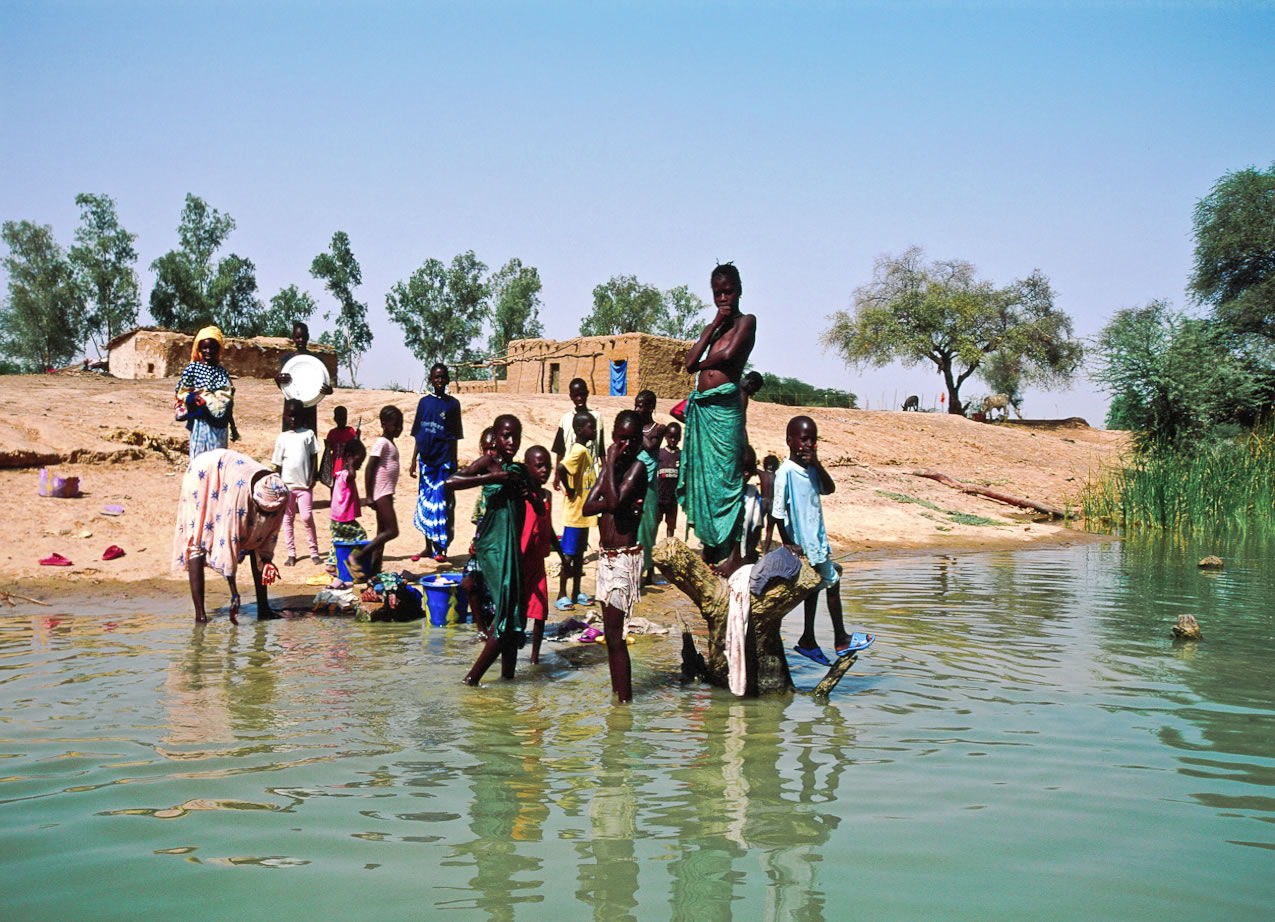


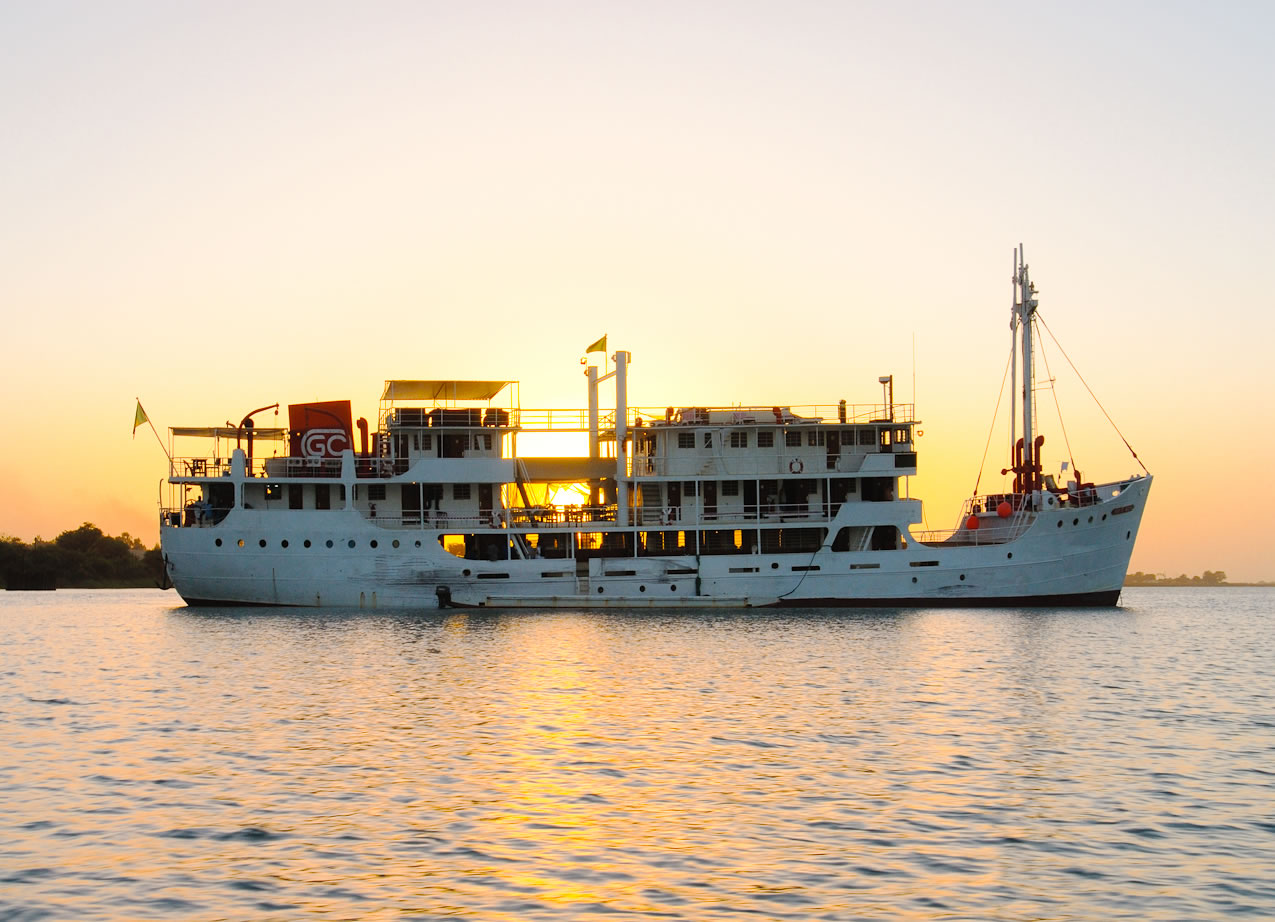

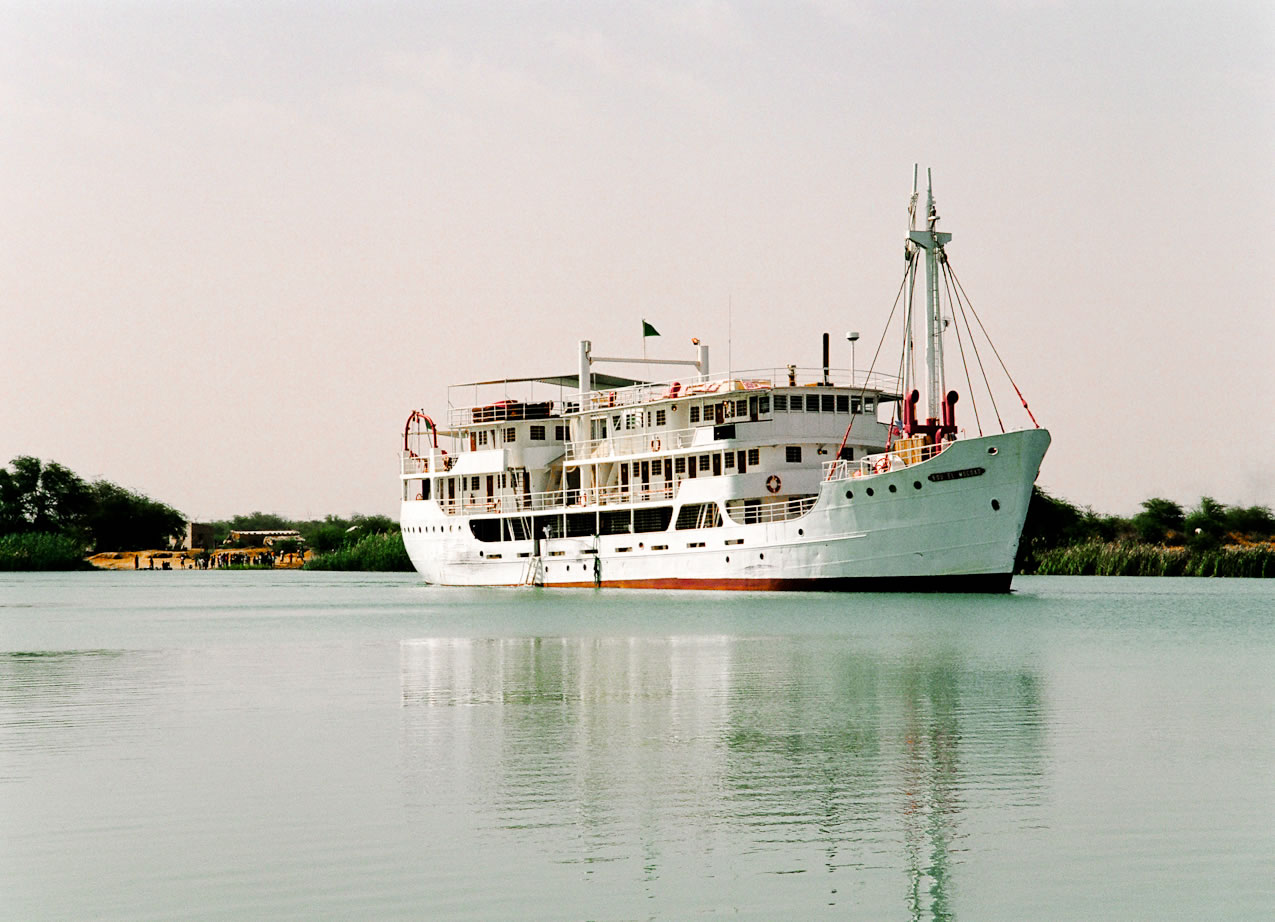
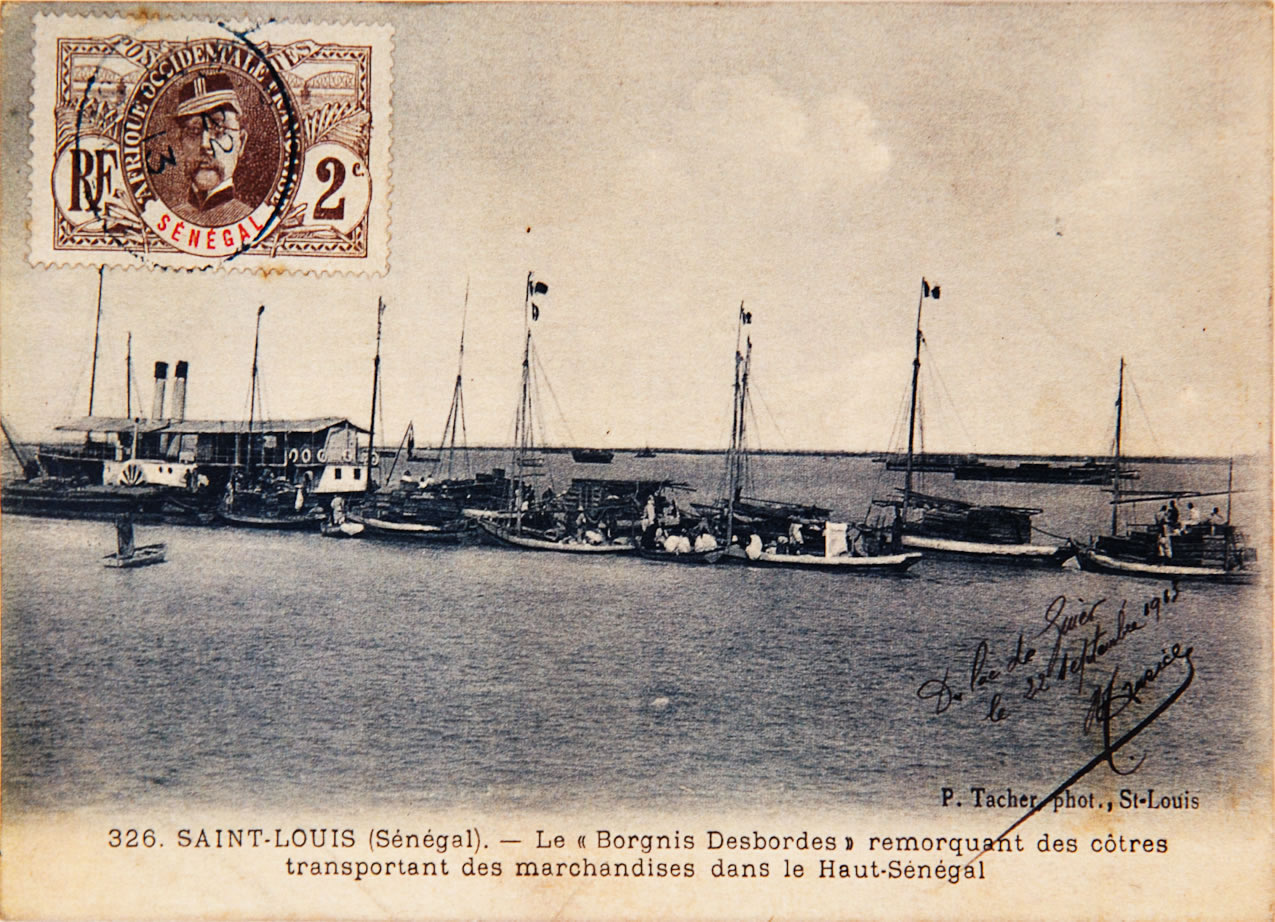

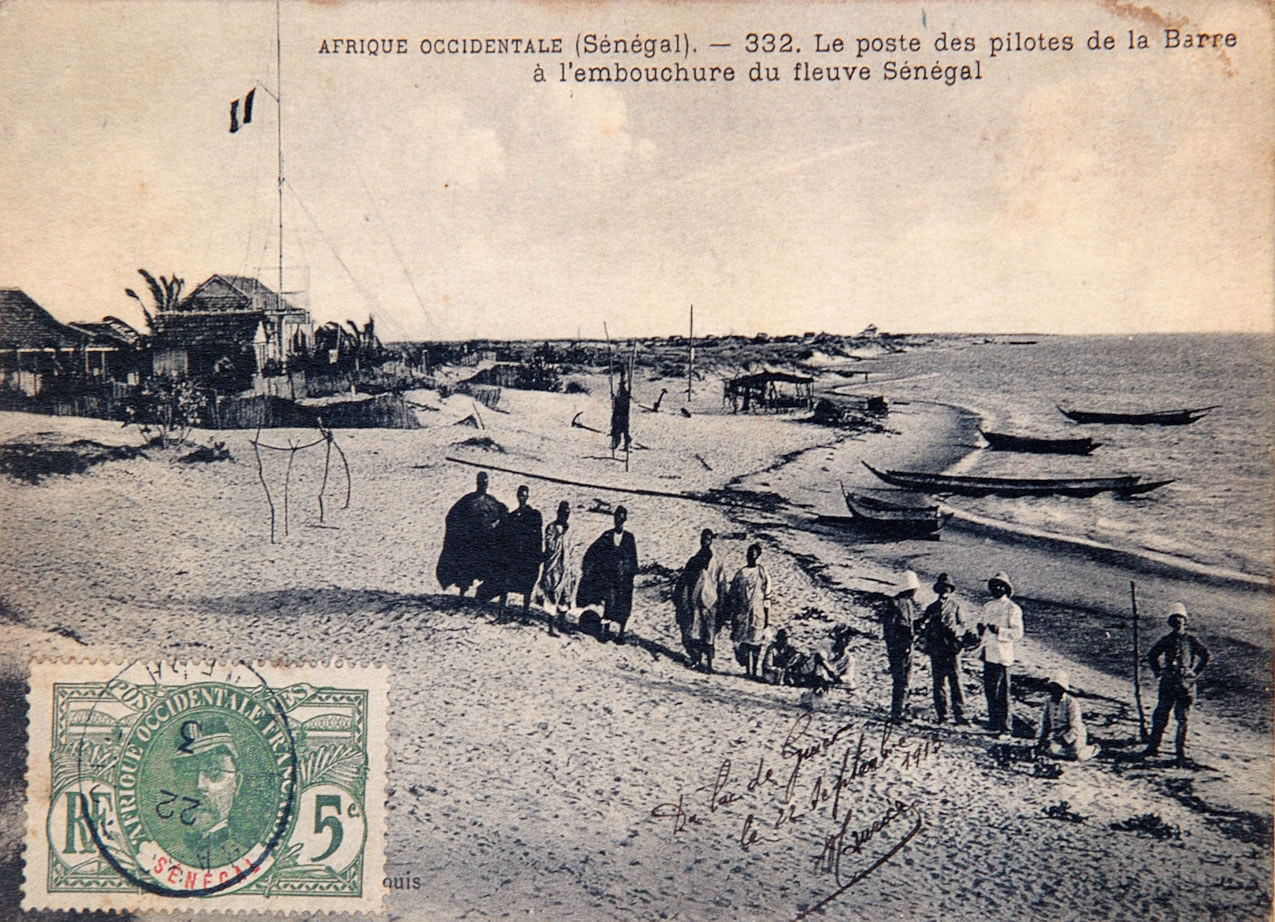

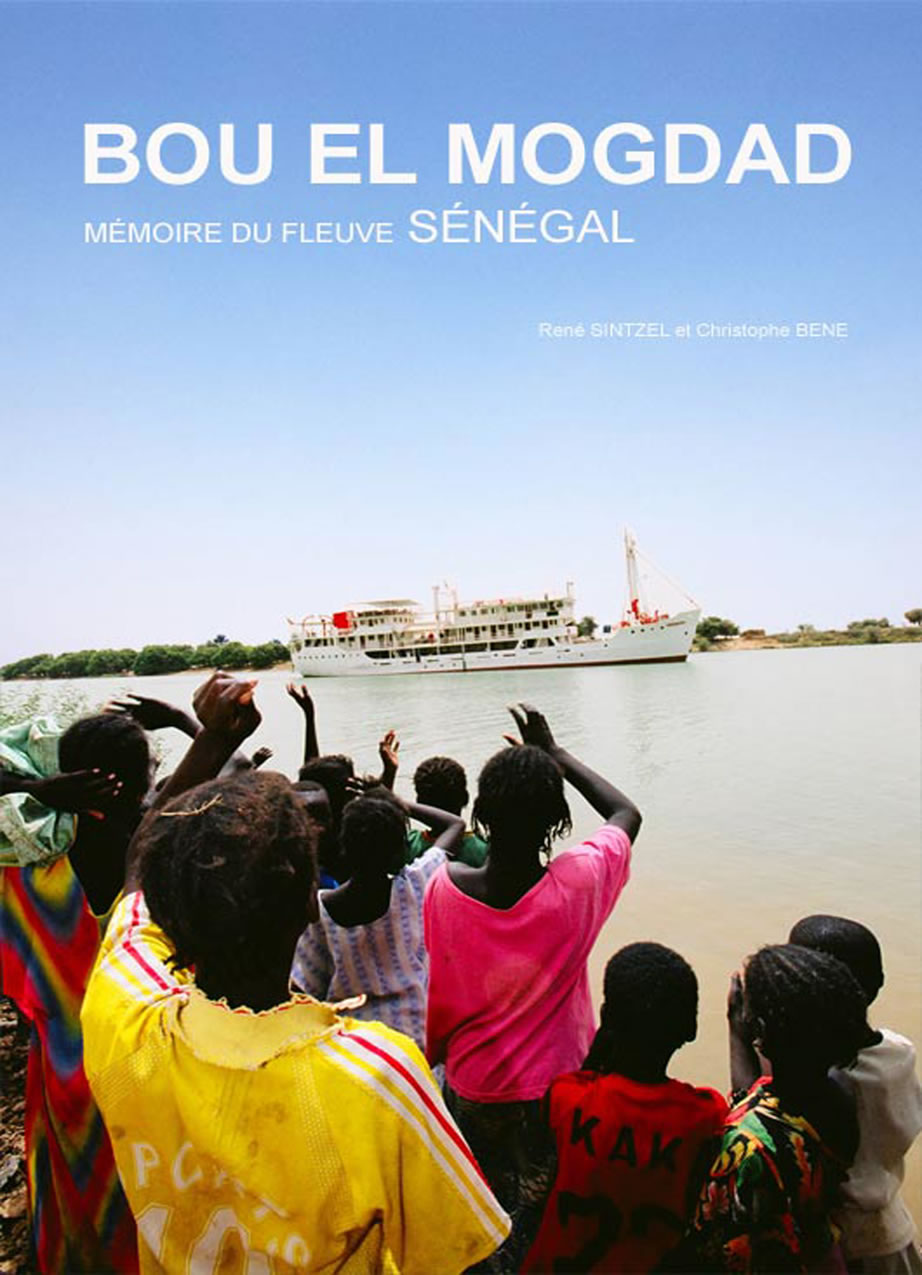
THE RETURN OF THE BOU-EL- MOGDAD Built in 1950 in the workshops of Holland, River boat.
Story by René SINTZEL - Photos by Christophe BENE Once upon a time, there was an old village on a great river. On this river was a beautiful white boat. On the quays there was a boy, very young, who dreamed that one day he would board that boat, and captain it, and split the river’s green waters northwards, towards the country of the Maures, towards the profound depths of this Africa that had seen that boy born and which the boy cherished with the love of a son. One day, if God so willed it, he would be that boat’s captain. The year is 1969, this village is Saint-Louis in Senegal, the boy’s name is Jean-Jacques Bancal, and the boat is the Bou el Mogdad. Built in 1950 in the workshops of Holland, it’s a steel ship 52 meters long, a small craft for navigating rivers. It was baptized with the name of a black Mauritian, a highly cultured, wily diplomat, faithful to France which he served in the 19th Century and for which he was, as first interpreter for that conqueror, builder, and administrator of genius, Governor Faidherbe, the very first African to receive the Légion d’Honneur. The ‘Bou’ will begin its career on the river Senegal in 1951. Its owner, the Messageries du Sénégal, had it carry freight, post and passengers, from Saint-Louis to Kayes in Mali, linking the first capital of Senegal and French Occidental Africa to the old trading posts where the French had exchange points anchored in the tumultuous Fouta Toro, land of Peuhls and Toucouleurs, and neighboring, on the right banks, the Maures, so often the source of revolt and war. Source of life for the West African part of the Sahel, the Senegal river was, like all African rivers, an ideal way of penetrating these immense lands from which the West reaped so many riches. A journey to the end of night, in the heart of a land that caused awe, and fear, and fascination. These waters have carried the Arab boutres, slender native canoes, Royal ships, and the merchant ships that sold tree gum, ivory, and captives! The drums of war have been silenced, the old sailors from St. Malo and the Vendee, the feared Maures, the industrious Arabs, the bold Métis and the beautiful Signares, once leaders of Saint Louis commerce, are no longer here. Only the river remains, unhurried, majestic, unconquered. And on that river - the Bou el Mogdad. Jean-Jacques Bancal is no longer the boy he was in the Sixties. Today, he’s at the head of company that looks after tourism, hotel management, gastronomy and travel. Above all, he is the heir of a grande famille from Saint-Louis, whose founder, a surgeon from the French Marines, arrived on the island, in 1780, to forget an impossible love. A man that belonged to those intrepid Europeans who brought wealth to this town, the first French town in Africa, who mingled with natives while maintaining their own ways of life, creating an aristocracy of métisse and Christians who would come to dominate the city and, for certain among them, like André Guillabert, the country’s political scene. Jean-Jacques Bancal continued to dream until the day the dream came true. George Console, the Bou’s last owner, had thrown down his anchor and finished his life of adventuring – God knows he’d had his share! He had taken over the boat from the Messageries du Sénégal who had abandoned it along the quay in 1968, where it had become a playground for the local children. Console, the ‘King of the River’, would use it for freight and humanitarian missions during the great famine of the Seventies. It was during these years of misery that the ‘Bou saga’ began. It came bearing gifts like ‘Father Christmas’, a literal ‘life boat’, that carried with it the light of hope. The Bou became mythical, something from a fairytale. Bonds forged between the crewmembers and the people along the banks, and the boat itself carried this love down through the years. But after the Diama dam was built in 1982, Console was constrained to leave the Senegal river and go further south, where the Bou served as a local cruise ship, and there it would remain for the next twenty years, before finally being sold again. Jean-Jacques Bancal quickly gets his friends together, and they buy the Bou el Mogdad in July of 2005. The kid from Saint Louis saw his dream coming true, and now he had to keep it alive. He had to make the Bou profitable again, and take up its old journey. One obstacle remained: for the Bou to get to Saint Louis, it had to pass under the seven steel arches of the Faidherbe bridge, whose moving parts had not been used in over 20 years, and no one was sure that if, once opened, they could be closed again. On October 16, 2005, borne on the cries from the crowd, the Bou el Mogdad passed under the Faidherbe bridge and moored along its old quay, proudly filling Jean-Jacques Bancal’s eyes with tears. The inaugural cruise was in November, 2005, joining friends, luminaries, national stars, like Senegal’s much loved Richard Borhinger, and, from its first voyage, the only cruise ship on an African river. But the show was elsewhere: along the riverbanks, incredulous, wonderstruck, a whole people had gathered to wave along the return of the mythic ship. Kids left school, washerwomen danced and jumped in the water, men shouted joyously, prayed and some shot into the sky, in homage, from the rusty rifles left from slave times.These secret, magical ties, almost religious, between the Bou and these river people - believed to have been almost lost, forgotten, defeated behind the driving heat and the sand storms and life’s bitter struggles - were instantly reestablished, as strong, as profound, and as true as they had always been. The boat’s twenty-year absence was forgotten in the blink of an eye, for in Africa something lives so long as it is present in the memories of others. “And the ship sets sail… ” The cruise begins in a festive atmosphere. From day one, the river will reveal its gifts of wonder. The Bou departs from the reed-covered banks. We penetrate, by waterway, the National Bird Park of Djoudj. The clear voice of our guide lists the species we meet: King Blue Herons, Golden Eagles, African Fish-Eagles, cranes of all types, pelicans in flight, full-beaked, the discreet Ibis of the Nile, colonies of cormorants. Suddenly, a family of warthogs shoot like a cannonball down some trail. A crocodile lazily eyes a flock of ducks. Here are gathered, among 370 different species, over 3 million birds, half of which come from abroad (Europe, the Middle East, Asia). They come to reproduce under the welcomed rays of the African sun and easily find, in the peace of the reserve, an abundance of the fish they need (Threadfins, Red Carp, Silurid fish …). Created in 1974 on 12, 000 hectares, the Park - the third largest in the world - now extends over 18,000 hectares of rigorously surveyed and protected land. After passing the dam in Diama, the waters change, become calmer, greener, deeper. The sandbanks have disappeared in the depths, but Baba, the ship’s taciturn pilot, child of this country, with more than seventy years behind him (but who knows his real age?) is back at the wheel, and continues to work the rudder. Memories of depths from long ago? A tip of the hat for the spectators? Or a way of affirming control of his art, guiding this ship? He seems to be saying: ‘I’ve got you, River Senegal, I can work you without trepidation, the Bou moves beneath my control, I don’t fear the genies of the waters.Approaching Richard Toll now, “Richard’s Gardens”, named after the botanist who once performed numerous studies experiments there, has since become immense fields of sugarcane. Each night, the plants are stripped of their leaves by a fire that lends a purple sheen to sky; in the morning, they are cut down, and Senegal Sugarcane Company has reaped 70% of its supply. The rest? You only have to see, as twilight descends, the curious mix of canoes crossing from the Mauritian riverbanks to the Senegalese to know where it comes from… But the factory in Richard Toll has helped the town develop, and the hospital there, free for everyone, is an exception in Senegal. The passengers rejoin the boat, filling the 28 cabins that all face outwards. The dining room is full and the bar lively; tonight it’s crayfish and threadfin on the menu, fresh from the river. Not far, on the left -banks, among immense acacias, stands a sumptuous ruin, the “folly” of the Baron Roger, constructed by a governor in the 19th century. Another whim, like the river’s caprices … The riverbanks draw nearer now, villages are pressed along the sides, boats ferry between – the populations are cousins. Yesterday, the border was 30 kilometers further north, the river brings together more than it separates, and the Black Mauritians cross it at will, buying and selling all sorts of goods. The houses are made of banco, an ancient material closer to adobe, in its superior insulation, than to the everyday brick, which, alas, is slowly taking over. Here, Wolofs, Peuls and Toucouleurs mix and mingle. Here is the approach into Fouta, a land given over to immense herds of cows, a vast plain of savannah swept over by suffocating winds and sands. A quay lined with Kapok trees, the remains of a fort, houses aligned in a Provencal manner as if we were on the set of Marcel Pagnol film: this is Dagana, ancient trading post where the sole wealth today seems to be these children splashing gaily through the river. It was, in another time, here that the sons of Bordeaux and of Marseille came, attracted by its exoticism, by the chance of making a name for themselves far from their homeland, or perhaps excluded from it through some trifle. They discovered heat, solitude, sickness, and unremitting work, at the ends of the Earth. To be sure, it was what is called colonialism, but these "petits Blancs”, these “little white men” who came weren't so different from their African neighbors, and gold never covered the streets of Dagana. A day of rest for the Bou. On land, next to a village full of mango trees, a meal awaits us - "Tiep bou Dien", rice with vegetables and fish, cooked in red oil with a taste of tamarind. A group of passengers find the chance to get to know each other better at the picnic and to meet the local villagers. The end of trip is approaching: further up, at the bend in the river, you can see the roofs of Podor, the last stop for the moment, though the boat will undoubtedly venture further in the years to come. Podor is the archetype of the trading post at the end of the world. The quay, the Christian mission and school, the marketplace in ruins which the setting sun alone still visits, an old fort erected by Faidherbe who well-understood that the Maures and the Toucouleurs, fierce warriors and ardent Muslims, would come hurling themselves at his fellow countrymen, who were but two hundred, in uniforms ill-suited for the suffocating heat, contemplating their own "tartar steppe", from whence these desert horsemen came. Today, Baba Maal, the great Pular singer, son of Podor, is trying to bring new life to his village with his "Blues on the River" Festival. His fight is the same as Jean-Jacques Bancal's: to revive hope, respect for the historic culture and help discover the Other, the tourist, the foreigner. What remains from this slow and unhurried journey, this five-day cruise up the river?A kaleidoscope of images of another Africa, little known, little visited by the everyday tourist. The flight of a pelican, the startled sprinting of a little donkey, the girls rigid-backed, in their colorful robes, with their breasts firm, their bodies supple and hard like cured leather, and who stop for a moment in their interminable wash work and watch the Bou passing, with a touch of emotion. The sentiment of having been, for a time, a part of some untouched Nature, carried there upon this boat, in its stoic silence, which makes us dream, like we were eight-years old again, of adventure and of love, but which, above all, keeps its promises. Africa is there, omnipresent, ever-changing, more beautiful still when seen upon the river-flow. René SINTZEL Index 1 : Technical chart of the Bou-el-Mogdad Built in 1950 in the workshops of Holland, River boat. steel ship 52 meters long, 10,6 meters large steel riveted ship Draught: 2,5 m Engines : 2X400 CV Sulzer . 300 T/mn Middle Speed : 7 nœuds 3 Generating set. 1 annexe boat 80 places ( a barge) 1 annexe 7 places with 95cv engine 28 cabs with one suite ( all situated with a view on the exterior deck) WC and showers at all stage. A little swing-pool with filtered water. 2 solarium / outdoors lounges 1 Restaurant en terrace 1 Closed & Interior restaurant 1 Bar-Pub 1 Reading space 1 Shop 1 massage salon room Crew & Services 1 Capitain licenced 1 Live-giving person – Managing director 20 staff members ( helmsman, seaman, cookers, waiters, house and lady’s maid, guide) .LE RETOUR DU THE BOU-EL- MOGDAD Un bateau construit dans les chantiers hollandais en 1950.Une croisière sur le fleuve Sénégal.
Un reportage de René Sintzel, photos Christophe Bene Il était une fois une ville, une vieille ville au bord d’un grand fleuve. Sur ce fleuve il y avait un bateau, un beau bateau blanc. Sur le quai était un garçon, un très jeune garçon. Le jeune garçon rêvait ; un jour il montera à bord, il prendra les commandes et fendra les eaux vertes du grand fleuve, vers le Nord, le pays des Maures, vers les profondeurs de cette Afrique qui l’a vu naître et qu’il aime d’un amour de fils. Un jour, si Dieu le veut, il sera le maître du bateau. Nous sommes en 1969,cette ville c’est Saint-Louis du Sénégal, ce gamin s’appelle Jean-Jacques Bancal, le bateau c’est le Bou el Mogdad. Construit en 1950, dans des chantiers hollandais, c’est un navire d’acier de 52 mètres, à faible tirant d’eau pour une navigation fluviale. On l’a baptisé du nom d’un Négro-mauritanien, fin lettré, diplomate retors, fidèle à la France qu’il servira au 19ème siècle et qui sera, au titre de premier interprète du Gouverneur Faidherbe, conquérant, administrateur et bâtisseur génial, le tout premier Africain à recevoir la Légion d’Honneur. Le « Bou » va commencer sa carrière sur le fleuve Sénégal en 1951. Son propriétaire, les Messageries du Sénégal, lui fait faire le fret, le courrier, les passagers, de Saint-Louis à Kayes, au Mali. Il reliait ainsi la première capitale du Sénégal et de l’A.O.F. aux vieux comptoirs dont les Français avaient fait leurs têtes de pont, dans ce tumultueux Fouta Toro, pays des Peuhls et des Toucouleurs, voisins des Maures sur la rive droite, qui fut agité si souvent de révoltes et de guerres. Ligne de vie du Sahel ouest-africain le fleuve Sénégal était, comme tous les fleuves africains, une voie de pénétration idéale d’immenses territoires d’où l’Occident tiraient ses richesses. Portes des voyages au bout de la nuit, au cœur des ténèbres d’un continent qui fascinait et effrayait tout à la fois. Ces eaux en ont-elles porté des boutres arabes, des pirogues élancées, des vaisseaux de la Royale, des navires marchands aux ventres bourrés de gomme, d’ivoire, de captifs ! Les tambours de guerre se sont tus, les matelots malouins ou vendéens, les Maures redoutés, les industrieux Arabes, les audacieux Métis et les belles Signares , maîtresses du commerce saint-louisien, ne sont plus. Reste le fleuve, lent, majestueux, incontesté. Et sur le fleuve le Bou el Mogdad. Aujourd’hui Jean-Jacques Bancal n’est plus le gamin des années 60, c’est un chef d’entreprise qui allie tourisme, hôtellerie, voyages et gastronomie. Il est surtout l’héritier d’une grande famille de Saint-Louis, dont le fondateur, un chirurgien de Marine français, vint se fixer, en 1780, sur l’île, pour y oublier un amour impossible.Il fit partie de ces Européens aventureux venus valoriser cette cité merveilleuse, première ville française d’Afrique, et qui en se mêlant aux locaux, tout en gardant leurs traditions, créèrent une aristocratie métisse, chrétienne, qui domina les activités de la ville et même, pour certains, comme André Guillabert, la politique du pays. Jean-Jacques Bancal rêve encore et un jour ce rêve devient possible. Voilà que le dernier propriétaire du « Bou », Georges Console, jette l’ancre de sa vie d’aventures- Dieu sait qu’il en a vécu ! Il avait repris le bateau aux Messageries du Sénégal qui l’avaient abandonné en 1968 à quai où il servait de terrain de jeux aux enfants. Console, le « Roi du fleuve », va l’exploiter pour le fret et aussi comme vecteur d’aide humanitaire pendant la grande sécheresse des années 70. C’est dans ces années de misère que commence la « saga du Bou », bateau Père Noël, navire sauveur, nef d’espoir et de lumière. Le Bou devient un vaisseau mythique, un personnage de contes. Une relation passionnelle entre les hommes du bord, les gens des rives et ce bateau s’établit et se transmettra au cours des années. Mais Console se voit contraint de quitter le fleuve, en 1982 suite à la construction du barrage de Diama, de s’établir plus au sud, dans le Saloum, de faire du Bou un bateau de tourisme, de croisière fluviale. Il le fera pendant plus de vingt ans, avant d’en décider la vente. Jean-Jacques Bancal réunit des amis en hâte. Ils achètent le Bou el Mogdad en juillet 2005. Le gamin de Saint-Louis a réalisé son rêve, reste à le pérenniser, le rentabiliser, lui faire reprendre son parcours d’antan. Il y a un obstacle de taille : pour que le Bou retourne à Saint-Louis il lui faut passer le Pont Faidherbe aux sept arches d’acier, or son arche mobile n’a pas fonctionné depuis vingt ans et nul ne sait si elle se refermera après son hypothétique ouverture. Le 16 octobre 2005, sous les vivats de la foule, l’arche s’ouvre, le Bou el Mogdad passe le Pont Faidherbe et retrouve son quai. Jean-Jacques Bancal a les larmes aux yeux. Croisière inaugurale en novembre 2005, les amis, les notables, quelques stars aussi dont Richard Borhinger, grand amoureux du Sénégal, sont du premier voyage du seul bateau de croisière sur un fleuve africain. Mais le spectacle est ailleurs : sur les rives du fleuve, incrédule, émerveillé, en transe, tout un peuple est là pour saluer le retour du bateau mythique. Les enfants ont déserté l’école, les lavandières dansent ou se jettent à l’eau, les hommes hurlent de joie, prient et certains, en hommage, déchargent vers le ciel d’antiques pétoires, souvenirs des temps de traite. Le lien secret, magique, presque religieux qui unissait le bateau et les gens du fleuve et qu’on croyait perdu, oublié, noyé dans les chaleurs, les vents de sable et l’âpreté de la vie s’est rétabli à l’instant, aussi fort, profond et vrai. L’absence de vingt années n’a pas comptée, tant il est sûr qu’en Afrique vivre c’est exister dans la mémoire des autres. « E la nave va… », la croisière commence dans cette ambiance festive ; dès le premier jour le fleuve va déballer ses merveilleux cadeaux. Le « Bou » s’immobilise au milieu des roseaux qui couvrent les rives. Nous pénétrons, en barge, dans le Parc National des Oiseaux du Djoudj. La voix claire du guide énumère les espèces rencontrées : Hérons cendrés, aigle royal et aigle pêcheur, grues de toutes sortes, pélicans au vol de bombardier lourd, discret ibis du Nil, colonies de cormorans. Soudain une famille de phacochères passe en boulet de canon sur quelque layon. Un crocodile paresseux contemple d’un œil morne une tribu de canards. Ici sont rassemblés en 370 espèces plus de 3 millions d’oiseaux dont la moitié vient de l’extérieur ( Europe, Moyen-Orient, Asie). Ils vont se reproduire sous les rayons du soleil africain et sont bien aise de trouver, dans la paix de la réserve, d’abondantes ressources en poisson ( capitaines, carpes rouges, silures…). Créé en 1974, sur 12000 hectares , le Parc (le troisième mondial) en compte 18000 aujourd’hui ; il est rigoureusement surveillé et protégé. Depuis le passage du barrage de Diama les eaux ont changé, elles sont plus calmes, plus vertes, plus profondes. Les bancs de sable ont disparu sous des fonds suffisants, mais Baba, le pilote taciturne, l’enfant du pays qui à soixante dix ans passés ( mais qui connaît son âge véritable ? ) mène à nouveau le Bou, donne de fréquents coups de barre. Mémoire des hauts fonds d’antan ? Clin d’œil aux spectateurs ? Ou encore manière d’affirmer sa maîtrise, son art ? Il semble dire : « Tu es à moi fleuve Sénégal, je te laboure sans peur, le Bou vibre sous ma poigne, je ne crains pas le génie des eaux ». Vers Richard Toll maintenant, les « jardins de Richard », un botaniste qui y fit nombre d’expériences, sont devenus un immense champ de cannes à sucre ; chaque soir elles sont débarrassées de leur feuillage par le feu qui donne aux cieux des lueurs pourpres, au matin on les coupe et la Compagnie Sucrière Sénégalaise arrive à produire 70% des besoins. Le reste ? Il n’est que d’observer, au crépuscule, le curieux manége de pirogues qui vont et viennent de la rive mauritanienne à la sénégalaise pour comprendre d’où il provient…Mais l’usine de Richard Toll a permis le développement de la ville et son hôpital, gratuit pour tous, est une exception au Sénégal. Des passagers rejoignent le bateau, nous sommes au complet dans les 28 cabines, toutes donnant sur les ponts extérieurs ; la salle à manger et le bar s’animent, ce soir langouste et capitaine au menu, salade fraîche des jardins du fleuve. Non loin, sur la rive gauche, au milieu d’acacias géants, une ruine somptueuse, c’est la « folie » du Baron Roger, qu’un gouverneur du 19ème fit ériger. Autre caprice d’un fleuve… Les rives sont plus proches maintenant, de petits villages à leurs bords, quelques bacs les relient, les populations sont cousines : hier la frontière était à 30 kilomètres plus au Nord, le fleuve est un trait d’union plus qu’une barrière et les Négro-mauritaniens le franchissent à tout propos, vendant ou achetant toutes sortes de marchandises. Les habitations sont en banco, ancien matériel proche de l’adobe aux qualités isolantes supérieures à celles de la brique de mortier qui, hélas, commence à le supplanter. Ici, Wolofs, Peuls et déjà Toucouleurs se côtoient, c’est l’approche du Fouta, territoire d’immenses troupeaux de bovins, vaste plaine de savane balayée d’étouffants vents de sable. Un quai planté de grands fromagers, les restes d’un fort, des maisons alignées en un décor provençal qu’on dirait sorti d’un film de Marcel Pagnol : Dagana, ancien comptoir marchand dont la seule richesse aujourd’hui semble être ces enfants splendides s’égayant dans le fleuve. Là sont venus jadis d’entreprenants fils de Bordeaux ou de Marseille, parfois attirés par l’exotisme, la perspective de réussir loin du pays ou encore mis à l’écart pour quelque peccadille. Ils y ont découvert la chaleur, la solitude, les maladies, le travail acharné au bout du monde. Certes, cela s’appelait le colonialisme, mais ces « petits Blancs » là n’étaient pas très éloignés de leurs voisins Africains et l’or n’a jamais coulé à Dagana. Journée de repos pour le Bou. A terre nous attend, près d’un village aux accueillants manguiers, un repas de Tiep bou Dien, riz aux légumes et poisson, cuit dans une huile rouge et parfumé au tamarin. Le groupe de passagers trouve dans ce pique-nique champêtre l’occasion de se mieux connaître et de rencontrer les villageois. C’est bientôt la fin du voyage, au loin, à la courbe du fleuve, on aperçoit les toits de Podor, dernière escale pour le moment, le bateau ira sans doute plus avant dans le futur. Podor est sans conteste l’image du comptoir du bout du monde. Un quai, sa mission chrétienne et son école, des entrepôts marchands en ruine mais que le couchant anime encore, un vieux fort érigé par Faidherbe qui savait bien que les Maures et les Toucouleurs, farouches guerriers et ardent musulmans, viendraient s’y heurter aux petits gars de France. Ils étaient là deux cent, dans leurs uniformes mal faits pour la fournaise, contemplant avec inquiétude leur « désert des tartares » d’où venaient les cavaliers des sables. Aujourd’hui, Baba Maal, le grand chanteur Pular enfant de Podor, tente de redonner vie à sa ville avec son Festival « Blues du Fleuve ». Son combat est le même que celui de Jean-Jacques Bancal : restaurer l’espoir, respecter les cultures et les faire découvrir à l’Autre, le visiteur, l’étranger. Que lui restera-t-il à celui-là de ce parcours de 250 kilomètres au rythme lent de la croisière de cinq jours ? Un kaléidoscope d’une autre Afrique, peu connue, peu parcourue par le touriste. Le vol d’un pélican, la course d’un ânon, des gosses qui jouent dans l’eau verte, des filles dressées, le pagne autour des reins, seins tendus, corps souple et dur comme lanière de cuir et qui délaissent pour un moment d’émotion, au passage du Bou el Mogdad, d’interminables lessives. Le sentiment d’avoir, pour un temps fait partie de la nature préservée, tant le bateau, cicérone silencieux, facilite les approches et peut-être aussi, de partager le rêve d’un gamin de huit ans, rêve d’aventure et d’amour, mais surtout promesse tenue. L’Afrique est là, omniprésente, toujours changeante, plus belle encore vue de l’eau. René SINTZEL Annexe 1 : Fiche technique du Bou-el-Mogdad Construit en 1950, Hollande, bateau fluvial. 52 m de long, 10,6 m de large Coque en acier riveté Tirant d’eau 2,5 m Moteurs : 2X400 CV Sulzer . 300 T/mn Vitesse moyenne 7 nœuds 3 Groupes électrogènes 1 annexe 80 places ( barge) 1 annexe hors bord 28 cabines dont une suite ( toutes donnant sur les ponts extérieurs) Toilettes et douches à chaque étage Une piscine à eau filtrée 2 solarium/ salons découverts 1 restaurant en terrasse 1 restaurant fermé 1 bar 1 espace lecture 1 boutique 1 salon de massage Equipage et Service 1 Capitaine breveté 1 Gérant de croisière/ animateur 20 membres ( timonier, matelots, cuisinier, serveurs, ménagère, guide) LE RETOUR DU BOU EL MOGDAD Mémoire du fleuve SÉNÉGAL © Christophe BENE - 2006 LÉGENDES PHOTOS - SELECTION DEF 1 - 25/04/2006 Ordre de présentation a respecter. 1- JOIE DES ENFANTS QUI SALUENT DE LA RIVE SENEGALAISE LE BOU EL MOGDAD QUI PASSE DEVANT EUX - SENEGAL - AFRIQUE - 3143_18A.tif 2- BOU EL MOGDAD NAVIGUE SUR LE FLEUVE SENEGAL - AFRIQUE - DOUBLE PAGE - 3141_23A0000.tif 3- JEAN -JACQUES BANCAL - PROPRIÉTAIRE ET ARMATEUR - PORTRAIT -3670_14A.tif 4- AERIEN BOU EL MOGDAD NAVIGUE SUR LE FLEUVE SENEGAL - AFRIQUE - IMG_1132 niv.jpg 5- BOU EL MOGDAD - FACE - DETAIL - FLEUVE SENEGAL - DSC_0091.TIF 6- AERIEN - FLEUVE SENEGAL - 1 - Au fil du fleuve.JPG 7- PIROGUE - FLEUVE SENEGAL - 3139_19A.JPG 8- AERIEN - FLEUVE SENEGAL - 3 - LES BOLLONGS - 0000.tif 9- BOU EL MOGDAD - DOUBLE PAGE - FLEUVE SENEGAL - AFRIQUE - 3143_03A.tif 10- BOU EL MOGDAD NAVIGUE - VUE SUBJECTIVE - FLEUVE SENEGAL - AFRIQUE - 3141_33A.tif 11- BOU EL MOGDAD - FLEUVE SENEGAL - 3/4 FACE - 141_18A0000.jpg 12- ENFANT BERGER REGARDE PASSER LE BOU EL MOGDAD - PORTRAIT - FLEUVE SENEGAL - 3139_32A.tif 13- BOU EL MOGDAD - FLEUVE SENEGAL - 3/4 FACE - 3141_21A.jpg 14- UNE PIROGUE VENU DES RIVES MAURITANIENNES ABORDE LE BOU EL MOGDAD - FLEUVE SENEGAL - 3140_24A.tif 15- BOU EL MOGDAD NAVIGUE - VUE SUBJECTIVE DU PONT SUPERIEUR - FLEUVE SENEGAL - AFRIQUE - DSC_0005.TIF 16- UNE PIROGUE VENU DES RIVES MAURITANIENNES ABORDE LE BOU EL MOGDAD - FLEUVE SENEGAL - 3140_25A.tif 17- BOU EL MOGDAD - FLEUVE SENEGAL - 3/4 ARRIERE - DSC_0022.TIF 18- VILLE DE ST LOUIS - POINTE SUD - SENEGAL - AFRIQUE - 3165_06.tif 19- PONT FAIDHERBE - ST LOUIS - FLEUVE SENEGAL - AFRIQUE OCCIDENTALE - 3165_200000.tif 20 -ILE DE ST LOUIS - POINTE SUD 3165_270000.tif 21- PORT DE PECHE DE GUET NDAR VILLE DE ST LOUIS - SENEGAL - 3165_E0000.tif 22- BRAS DU FLEUVE SENEGAL ENTRE L'ILE DE ST LOUIS ET LE QUARTIER DE GUET NDAR SITUE SUR LA LANGUE DE BARBARIE COTE OCEAN - 3176_15A0000.tif 23- RUE DE ST LOUIS - SENEGAL - DSC_00290000.TIF 24- AERIEN - LANGUE DE BARBARIE - SAINT LOUIS - SENEGAL – AFRIQUE OCCIDENTALE - 3148_11.jpg 25- AERIEN - VILLE ET PONT FAIDHERBE - SAINT LOUIS - FLEUVE SENEGAL - AFRIQUE OCCIDENTALE -3148_32.tif 26- POSTE DE COMANDEMENT - BOU EL MOGDAD - 3140_32A.JPG 27- PASSAGE DE L'ECLUSE DU BARRAGE DE DIAMA - 30CM DE MARGE POUR LE BOU EL MOGDAD - FLEUVE SENEGAL - AFRIQUE OCCIDENTALE - 3170_150000.tif 28- PASSAGE DE L'ECLUSE DU BARRAGE DE DIAMA - 30CM DE MARGE POUR LE BOU EL MOGDAD – VUE ARRIERE FLEUVE SENEGAL - AFRIQUE OCCIDENTALE - 3170_26.tif 29- PASSAGE DE L'ECLUSE DU BARRAGE DE DIAMA - 30CM DE MARGE POUR LE BOU EL MOGDAD - FLEUVE SENEGAL - AFRIQUE OCCIDENTALE - 3170_26.tif 30- PASSAGE DE L'ECLUSE DU BARRAGE DE DIAMA - LE BOU EL MOGDAD ATTIRE LES POPULATIONS RIVERAINES - FLEUVE SENEGAL - AFRIQUE OCCIDENTALE - 3170_E0000.JPG 31- 3000 PELICANS - INSOLITE - PARC NATIONAL DES OISEAUX DU DJOUDJ - SENEGAL - AFRIQUE OCCIDENTALE - DSC_0050atruc.tif 32- PARC NATIONAL DES OISEAUX DU DJOUDJ - COUCHE DE SOLEIL - SENEGAL - AFRIQUE OCCIDENTALE - 3168_340000.jpg 33- BOU EL MOGDAD NAVIGUE - VUE SUBJECTIVE - FLEUVE SENEGAL - AFRIQUE - 3160_30A0000.jpg 34- BABA A LA BARRE - POSTE DE COMANDEMENT - BOU EL MOGDAD -3162_330000.JPG 35- INSOLITE - BABA AUX COMMANDES LE BOU EL MOGDAD A ACCOSTE LA RIVE DE FACE ET MONTE SUR LA BERGE - FLEUVE SENEGAL - AFRIQUE OCCIDENTAL - E3164_28A.JPG 36- INSOLITE - BABA AUX COMMANDES LE BOU EL MOGDAD A ACCOSTE LA RIVE DE FACE ET EST MONTE SUR LA BERGE - FLEUVE SENEGAL - AFRIQUE OCCIDENTAL - 3162_21.tif 37- INSOLITE - BABA AUX COMMANDES LE BOU EL MOGDAD A ACCOSTE LA RIVE DE FACE ET AI MONTE SUR LA BERGE - FLEUVE SENEGAL - AFRIQUE OCCIDENTAL - 3162_0.tif 38- BOU EL MOGDAD NAVIGUE - VUE SUBJECTIVE RIVE MAURITANIENNE - FLEUVE SENEGAL - AFRIQUE - 3161_19.tif 39- VILLAGE SUR LA RIVE MAURITANIENNE - HABITATION EN BANCO - FLEUVE SENEGAL - AFRIQUE - 3160_09A0000.tif 40- UN ENFANT REGARDE PASSER LE BOU EL MOGDA SUR LA RIVE MAURITANIENNE DU FLEUVE SENEGAL - AFRIQUE - 3160_24A0000.tif 41- BRAS DU FLEUVE SENEGAL - BOU EL MOGDAD NAVIGUE - VUE SUBJECTIVE CONTRE/JOUR - FLEUVE SENEGAL – AFRIQUE OCCIDENTALE - 3163_11A0000.tif 42- BOU EL MOGDAD - FLEUVE SENEGAL - 3/4 ARRIERE - 3163_E0000.JPG 43- PIROGUE - FLEUVE SENEGAL - DOUBLE PAGE - AFRIQUE OCCIDENTALE - 3167_06A0000.JPG 44- BOU EL MOGDAD - FLEUVE SENEGAL – AFRIQUE OCCIDENTALE - 3163_34A.tif 45- PIROGUE - FLEUVE SENEGAL - AFRIQUE OCCIDENTALE - 3167_16A0000.JPG 46- PIROGUE - PECHE DANS LES ROSEAUX - FLEUVE SENEGAL - 3167_30A0000.tif 47-BOU EL MOGDAD NAVIGUE - VUE SUBJECTIVE - FLEUVE SENEGAL - AFRIQUE - 3172_120000.tif 48- BOU EL MOGDAD - DETAIL COMPAS - PONT SUPERIEUR - 3EME PONT - FLEUVE SENEGAL - AFRIQUE - 3172_34.tif 49- CREPUSCULE SUR DAGANA UN ANCIEN COMPTOIR MARCHAND - FLEUVE SENEGAL - AFRIQUE OCCIDENTALE - 3139_09A.tif 50- ARRIVEE SUR LE QUAI DU PORT DE DAGANA UN ANCIEN COMPTOIR MARCHAND - LES RIVERAINS ATTENDENT POUR VENDRE LEURS PRODUCTIONS ET PECHES DIVERSES ET RAVITAILLENT LE BOU EL MOGDAD - FLEUVE SENEGAL - AFRIQUE OCCIDENTALE - 3173_240000.tif 51- CONSTRUCTIONS COLONIALES - SUR LE QUAI DU PORT DE DAGANA ANCIEN COMPTOIR MARCHAND - FLEUVE SENEGAL - AFRIQUE OCCIDENTALE - 3173_02.tif 52- BAC -PASSAGE ENTRE LE SENEGAL ET LA MAURITANIE - POSTE DE DOUANE -LE TEMPS S'ARRETE LE BOU EL MOGDAD PASSE - DES RIVERAINS REGARDENT PASSER LE BOU EL MOGDA SUR LA RIVE MAURITANIENE DU FLEUVE SENEGAL ET SALUE LE BATEAU MYTHIQUE - AFRIQUE - 3175_270000.tif 53- BOU EL MOGDAD - FLEUVE SENEGAL - AFRIQUE - 3173_350000.tif 54- BOU EL MOGDAD NAVIGUE - VUE SUBJECTIVE - FLEUVE SENEGAL - AFRIQUE - 3174_36A0000.tif 55- PAYSAGE - CREPUSCULE - BOU EL MOGDAD - FLEUVE SENEGAL - AFRIQUE OCCIDENTALE - 3140_19A.tif 56- BOU EL MOGDAD - DOUBLE PAGE - COUCHE DE SOLEIL -FLEUVE SENEGAL - AFRIQUE OCCIDENTALE - 3179_050000.JPG 57- PAYSAGE - COUCHE DE SOLEIL - BOU EL MOGDAD - FLEUVE SENEGAL - AFRIQUE OCCIDENTALE - 3140_28A.tif 58- DETAIL DE LA COQUE DU BOU EL MOGDAD ABIMEE LORS DU PASSAGE DE L'ECLUSE DU BARRAGE DE DIAMA - FLEUVE SENEGAL - AFRIQUE OCCIDENTALE - DSC_0037.TIF 59- BOU EL MOGDAD - ACCOSTAGE - FLEUVE SENEGAL - AFRIQUE OCCIDENTALE - DSC_00340000.TIF 60- LE TEMPS S'ARRETE LE BOU EL MOGDAD PASSE - DES RIVERAINS REGARDENT PASSER LE BOU EL MOGDA SUR LA RIVE MAURITANIENNE DU FLEUVE SENEGAL - AFRIQUE - 3163_04A0000.tif 61- BOU EL MOGDAD NAVIGUE SUR LE FLEUVE SENEGAL - AFRIQUE OCCIDENTALE - DSC_00510001.TIF 62- JOIE DES ENFANTS QUI COURRENT SUR LA RIVE SENEGALAISE POUR SUIVRE LE BOU EL MOGDAD QUI PASSE DEVANT EUX - SENEGAL - AFRIQUE - DSC_00100000.TIF 63- JOIE DES ENFANTS QUI SALUENT DE LA RIVE SENEGALAISE LE BOU EL MOGDAD QUI PASSE DEVANT EUX - DANSE ET HYSTERIE – ENTRE DAGANA ET RICHARD TOLL -SENEGAL - AFRIQUE - DSC_00450000.TIF 64- POSTE DE COMANDEMENT - BOU EL MOGDAD - DSC_00540000.tif 65- BRAS DU FLEUVE SENEGAL - PIROGUE - RETOUR DE PECHE - RIVE SENEGALAISE - FLEUVE SENEGAL - AFRIQUE OCCIDENTALE - 3169_160000.tif 66- LA FOLIE DU BARON ROGER A RICHARD TOLL - DEBUT XIXEME - UN BOUT DE FRANCE AU SENEGAL - FLEUVE SENEGAL - AFRIQUE OCCIDENTALE - 3169_350000.tif 67- COMME SURGIT DE NUL PART UN ENFANT SORTIE DE LA VÉGÉTATION REGARDE PASSER LE BATEAU MYTHIQUE – BOU EL MOGDAD - BRAS DU FLEUVE SENEGAL - VEGETATION - RIVE SENEGALAISE - FLEUVE SENEGAL - AFRIQUE OCCIDENTALE - 3169_180000.tif 68- JOIE DES ENFANTS ET RIVERAINS QUI SALUENT DE LA RIVE SENEGALAISE LE BOU EL MOGDAD QUI PASSE DEVANT EUX - DANSE ET HYSTERIE DESFEMMES QUI ARRETENT LEURS LESSIVE POUR ACCLAMER LE BATEAU MYTHIQUE - ENTRE RICHARD TOLL ET PODOR -SENEGAL - AFRIQUE - DSC_00450000.TIF 69-LE QUAI DE LA VILLE DE PODOR - ANCIEN COMPTOIR MARCHAND DU BOUT DU MONDE - XIXEME SIECLE - RIVE SENEGALAISE - FLEUVE SENEGAL - AFRIQUE - DSC_0017.TIF 70- BOU EL MOGDAD CAFE -SUR LE QUAI DE LA VILLE DE PODOR - ANCIEN COMPTOIR MARCHAND - XIXEME SIECLE - RIVE SENEGALAISE - FLEUVE SENEGAL - AFRIQUE - 3143_29A.tif 71- FORT DE PODOR - VILLE DE PODOR - RIVE SENEGALAISE - FLEUVE SENEGAL - AFRIQUE - 3142_13A.jpg 71A - FORT OF PODOR - barrack and headquarters -SENEGAL RIVER - WEST AFRICA - 3142_05A0000.tif 72- FORT DE PODOR - CASERNE ET QG - VILLE DE PODOR - RIVE SENEGALAISE - FLEUVE SENEGAL - AFRIQUE - 3142_31A.tif 73- PORT DE PODOR -EPAVE D’UN BATEAU DATANT DU MILIEU DU SIECLE ABANDONNÉE SUR LE QUAI DEVNU LE TERRAIN DE JEU DES ENFANTS DE PODOR - VILLE DE PODOR - RIVE SENEGALAISE - FLEUVE SENEGAL - AFRIQUE - 3143_28A0000.tif 74- TRAFIQUANTS - PASSEURS DE SUCRE - ENTRE LES RIVES MAURITANIENNE ET SENEGALAISE - 5H10 DU MATIN - FLEUVE SENEGAL - AFRIQUE - 3140_22A.tif 75- PONT INFERIEUR ARRIERE DU BOU EL MOGDAD - ENTREE SALLE DES MACHINES - DSC_0033.JPG 76- DETAIL MOTEUR - BOU EL MOGDAD - SALLE DES MACHINES - DSC_0040.TIF 77- DETAIL MOTEUR - BOU EL MOGDAD - SALLE DES MACHINES - DSC_0013.TIF 78- CHEF MECANICIEN - SALLE DES MACHINES – TEMPERATURE AMBIANTE - 52 DEGRE DANS LA SALE DES MACHINES - BOU EL MOGDAD - DSC_003200000000.tif 79- DETAIL COMPTEUR - REGIME MOTEUR - 350 TOURS / MINUTES - BOU EL MOGDAD - SALLE DES MACHINES - DSC_0031.TIF 80- ASSISTANT MECANICIEN - SALLE DES MACHINES - BOU EL MOGDAD - DSC_0028.TIF 81- DETAILS COMPTEURS - REGIME MOTEUR - 350 TOURS / MINUTES - BOU EL MOGDAD - SALLE DES MACHINES - DSC_0042.TIF 82- ESCALIER - SALLE DES MACHINES- DETAIL - BOU EL MOGDAD - DSC_0045_1.TIF 83- PLAQUE D’IDENTIFICATION MOTEUR FAB - SALLE DES MACHINES - DETAIL - BOU EL MOGDAD - DSC_0043.TIF 84- BOU EL MOGDAD – COUCHE DE SOLEIL – CONTRE / JOUR - FLEUVE SENEGAL - AFRIQUE - DSC_0006_2.TIF 85- BOU EL MOGDAD - SUITE N°1 - DSC_00350000.TIF 86- BOU EL MOGDAD - BAR - RESTAURANT - DSC_0049.TIF 87- SAINT LOUIS - LE BORGNIS DESBORDES REMORQUANT DES COTRES TRANSPORTANT DES MARCHANDISES DANS LE HAUT SENEGAL - CARTE POSTALE 1900 - SENEGAL - AFRIQUE - DSC_0002A.tif 88- POSTE DES PILOTES DE LA BARRE A L'EMBOUCHURE DU FLEUVE SENEGAL - CARTE POSTALE 1900 - SENEGAL - AFRIQUE OCCIDENTALE - DSC_0010.TIF 89- DEPART D'UN CONVOI DE CHALANDS SUR LE FLEUVE SENEGAL - CARTE POSTALE 1900 - SENEGAL - AFRIQUE OCCIDENTALE - DSC_0003.TIF 90- BOU EL MOGDAD - PORTRAIT - PREMIER INTERPRETE DU GOUVERNEUR FAIDHERBE - PREMIER AFRICAIN A RECEVOIR LA LEGION D'HONNEUR - SENEGAL - AFRIQUE - DSC_0018.TIFChristophe Bene is a self-taught photographer currently based in Paris, France. His work is mainly inspired by the man/nature relationship. Straddling the border between art and documentary photography, Christophe Bene offers original prints saturated with colour. He colors, calibrates and retouches most of his photographs. Born in Douala, Cameroon in 1969, Christophe began shooting pictures at 16. After three years in French Polynesia, he left at 20 years old for a two-year degree in advertising communication in Paris followed by the French Conservatoire Libre du Cinéma before specializing at the ecole nationales superiore Louis Lumière in film and photography. From 1994 to 1999, he was assistant photographer, main photographer and post-producer for cinematic advertising.Upon returning to Africa in 1999, he undertook a wide range of work, shooting in Senegal in 2002 and directing the Triptik Senegal exhibition in collaboration with PICTO laboratories and various sponsors. He has won first prize in RED, the largest photo contest in the world, as organized by PHOTO.In 2002, he met the journalist René Sintzel, an Africa specialist, with whom he has since collaborated to produce documentaries on West Africa. In December 2002, he joined the GAMMA agency. In 2005, he worked together with JANVIER and DIGITAGENT - THE REPORT PARIS laboratories to produce the “Lion Kings of Medina” documentary. In 2006, WPN New York took charge of representing his photo documentaries and select art photos in the US. From 2008 to 2011, he covered the BENE DAKHLA music and slide festival in southern Morocco. He currently works on order for national and international brands, magazines and newspapers. His Aerial photography, which he has done since his first documentary, has become both his area of expertise and his passion. COMMERCIALS FUTUROSCOPE / Campagne d'affichage globale Europe 2019 Affiches 4x3 Métro / Bus / Presse magazine / Flyers Yannick NOAH / "Le même sang" Pochette CD / Livret / Affiches / Presse magazine THE NORTH FACE Affiche 4X3 / Presse magazine / Catalogue marque F-ONE KITE "All we do is Kiteboarding" Affiche 4X3 / Presse magazine / Catalogues marque NORTH KITEBOARDING Affiche 4X3 / Presse magazine / Catalogue marque HOALEN Surf Wear - The Saltwater Player Company Affiche / Presse magazine / Catalogue marque Bjoern DUNKERBECK - Portrait Affiche / Presse magazine / sponsoring AIR BUSINESS Center Campagne d'affichage globale / 16 Visuels Affichage 4x3 Aéroports - ADP / Presse magazine / Catalogues / Flyers HEINEKEN Campagne d'affichage Polynésie Française 1996 Affiche 4x3 / Bus / Presse magazine / Flyers COMMERCIALS / STUDIO PACKSHOT RAY-BAN / Sunglasses OMEGA / Speedmaster Professionnal TOM FORD / OUD WOOD VICTOR & ROLPH / SPICE BOMB PUMA / R78 RUNNER LA BONBONIERE NIGHT CLUB / NEW YORK HAVANA BOXING CLUB by Thierry LE GOUES DIO Connected Home CHATEAU DE SANTENAY - MERCUREY BIO - JUS DE CAROTTE EXHIBITIONS 1997 - KAINA - Polynesian travel 2002 - SENEGAL TRIPTIK - One day in Senegal 2005 - THE LION KINGS OF MEDINA 2009 - 5 PRINTS / 5 PHOTOGRAPHERS - photographs Group exhibition as part of FIAC at Galerie SPARTS REPORTS 2000 - A DAY IN SENEGAL - Senegalese Logbook 2003 - THE WHITE GOLD OF PINK LAKE 2003 - IVRY GITLIS VIOLINIST GLOBE TROTTER 2004 - THE LION KINGS OF MEDINA 2006 - THE RETURN OF THE BOU EL MOGDAD 2007 - THE GREAT MAGAL OF TOUBA 2008 - DAKHLA FESTIVAL 2009 - FANTASIA PUBLICATIONS / PRESS L'OBS - LIBÉRATION - LE MONDE - L'EXPRESS - ULYSSE - COURRIER INTERNATIONAL - LE PELERIN Magazine - REPONSE PHOTO - PHOTO Magazine - CHOC Magazine - PHOTO VIDEO NUMERIQUE - LA TERANGA (FRANCE & SENEGAL) - TEL QUEL (MAROC) - AMOUAGE (MAROC).

Phone / +33 6 25 01 72 88
Adress / 36, Av de Flandre - 75019 Paris - France